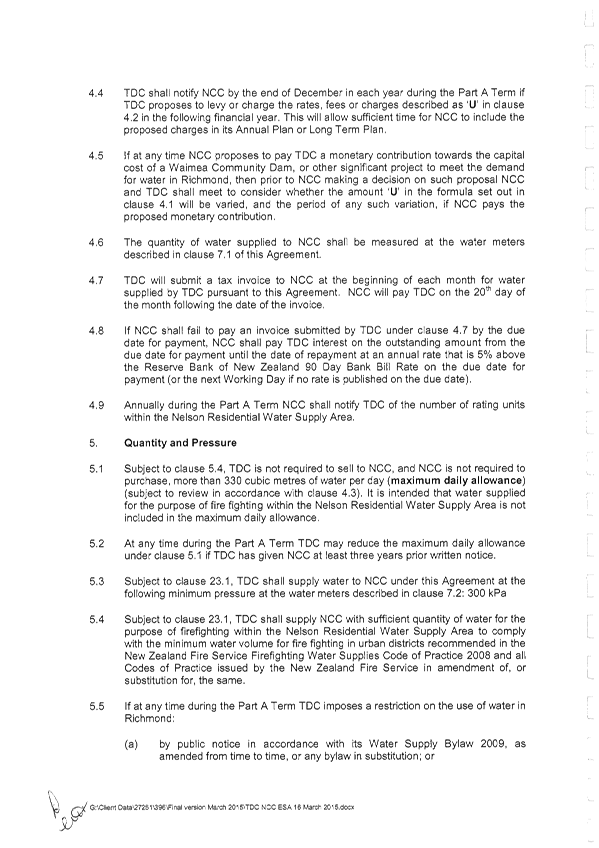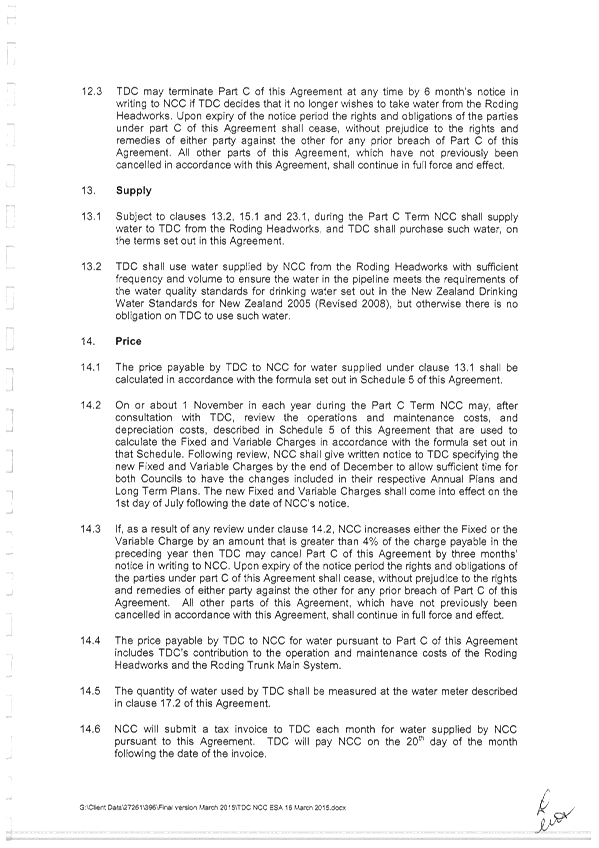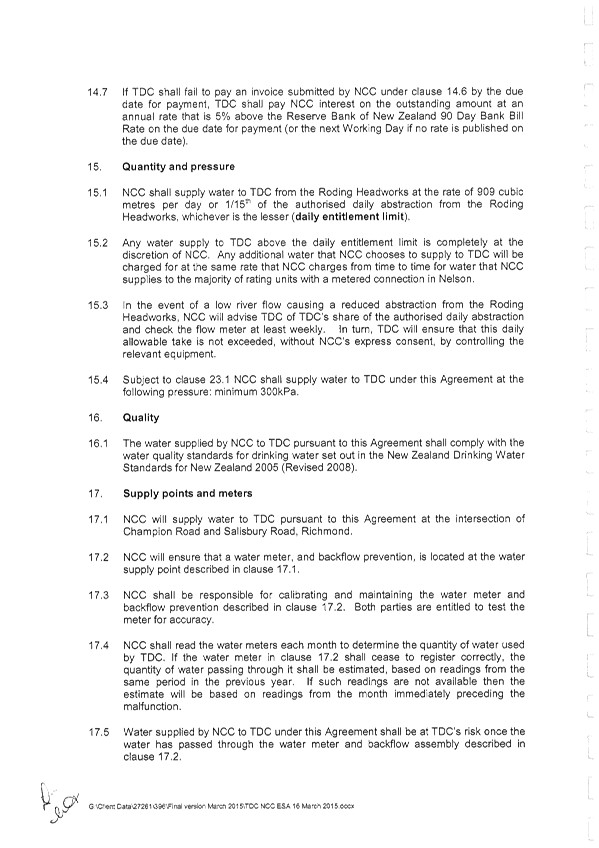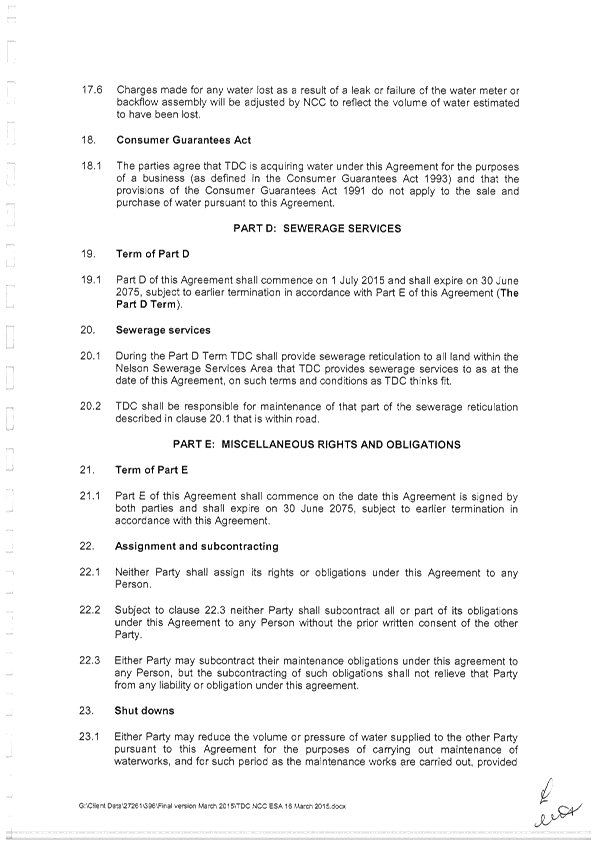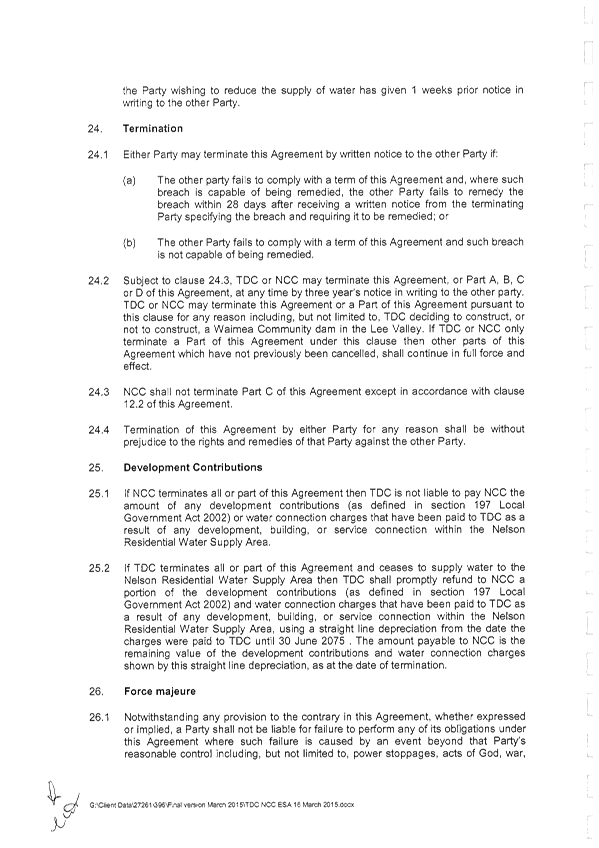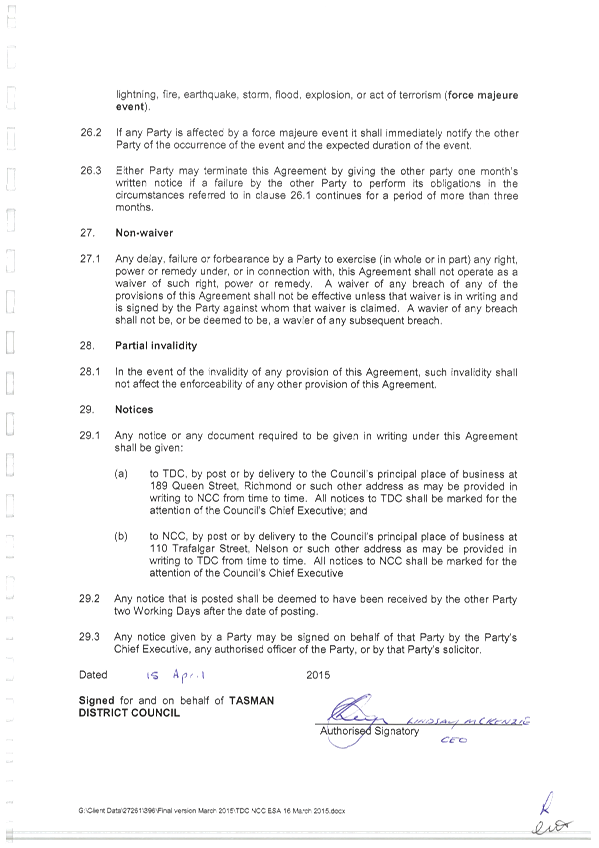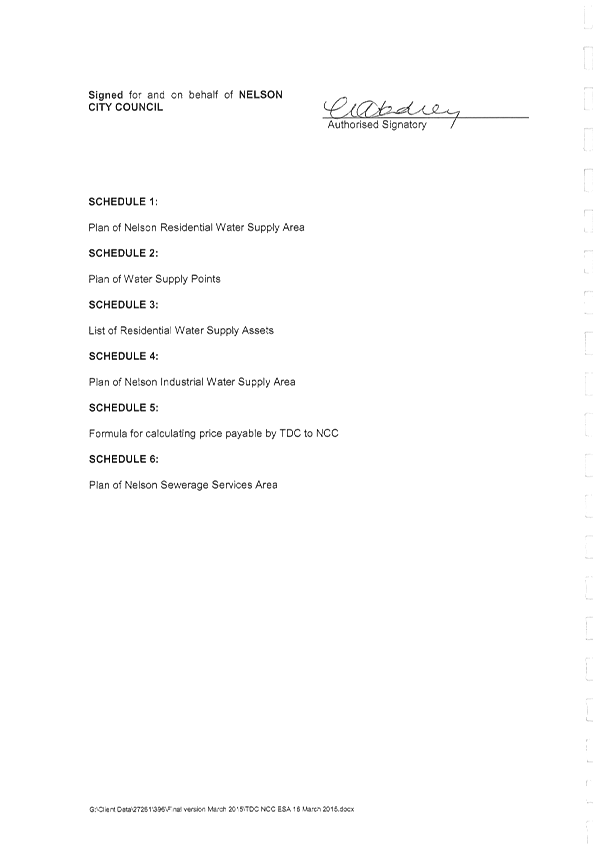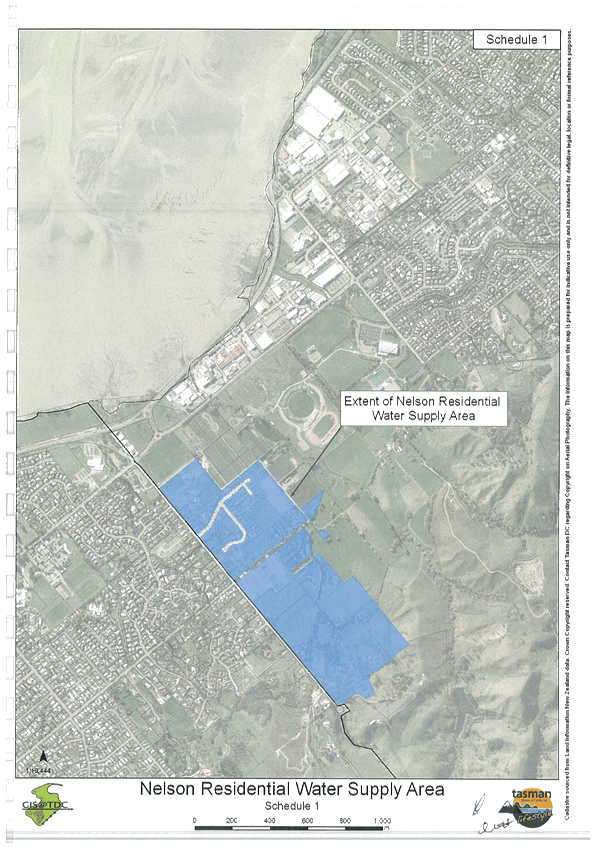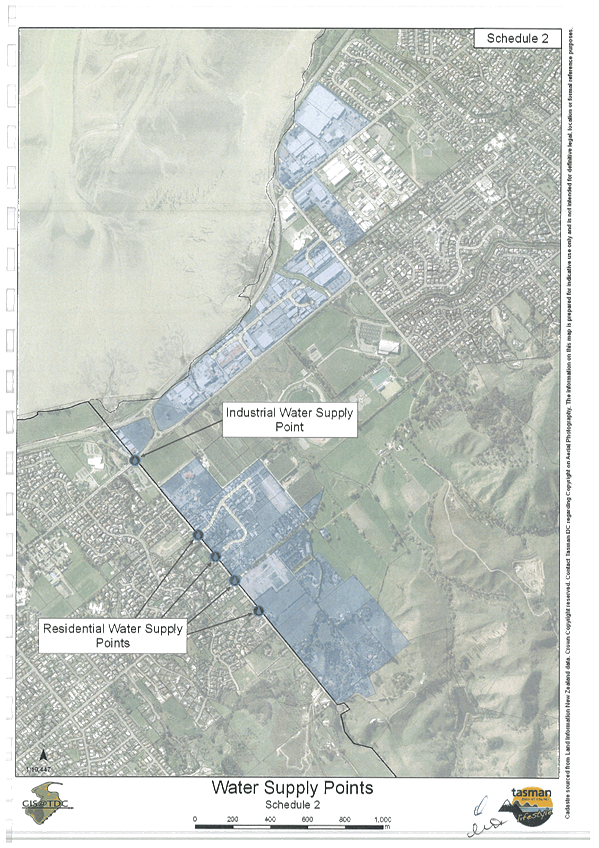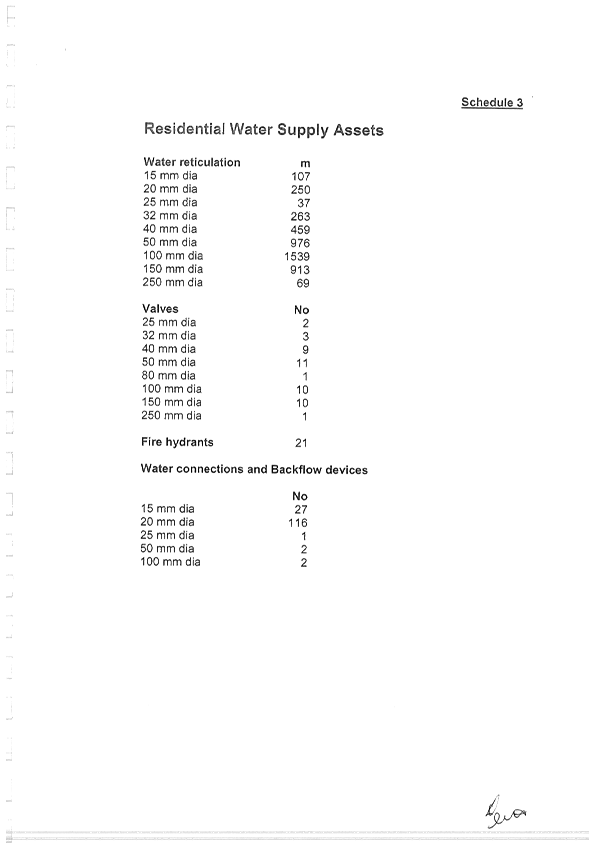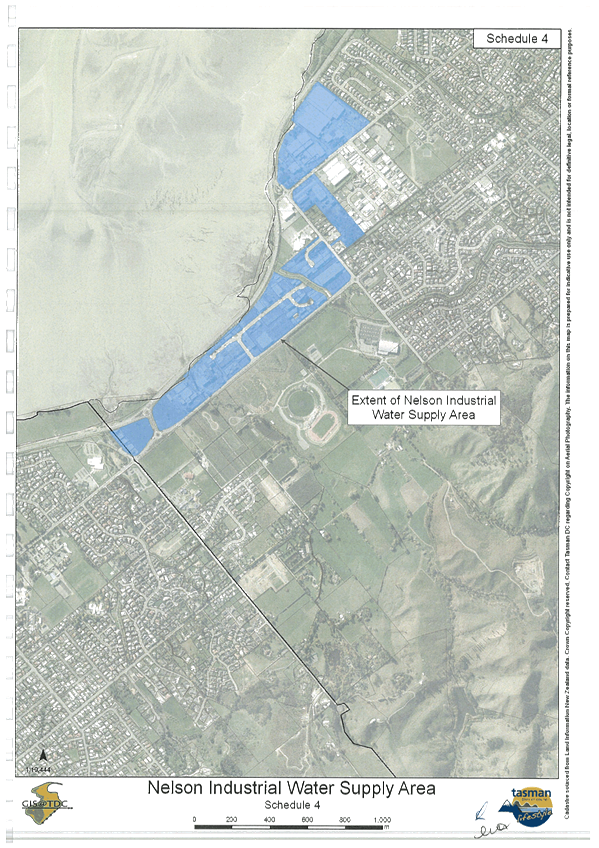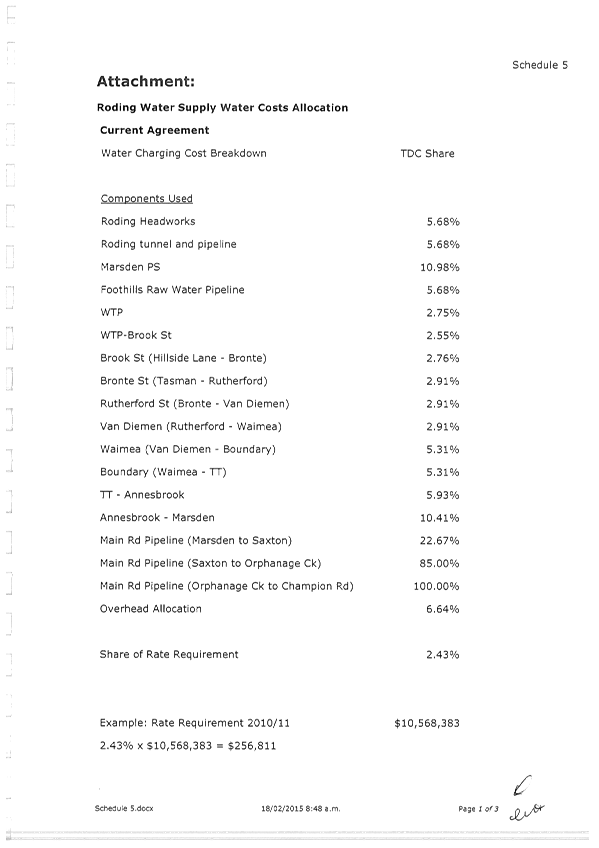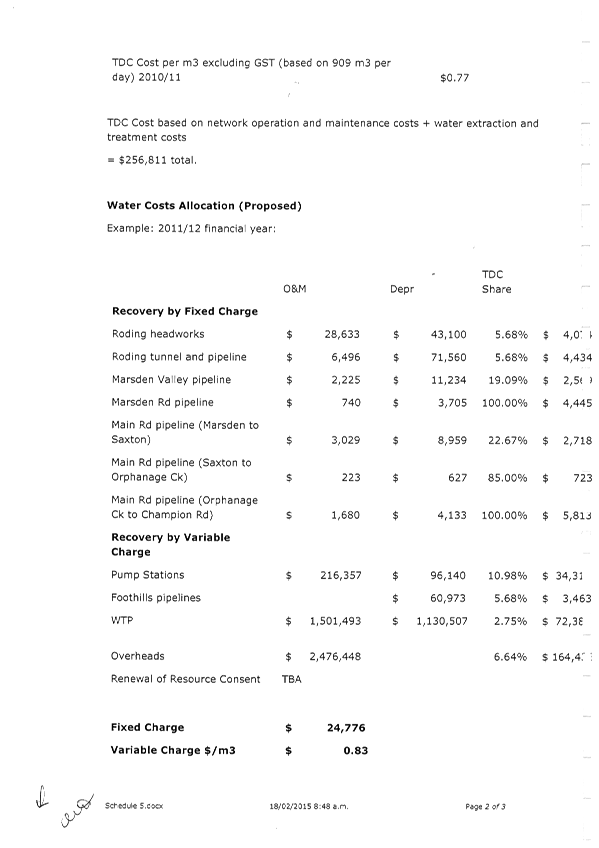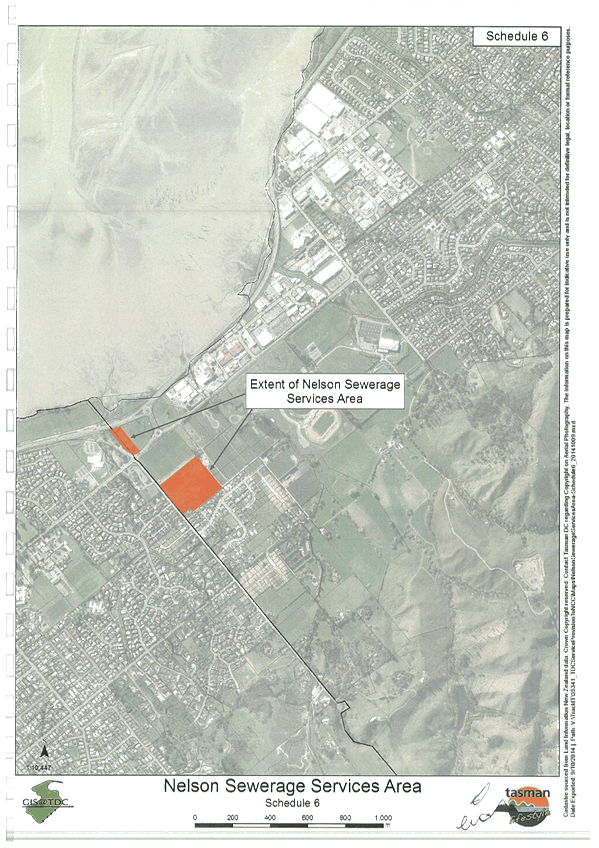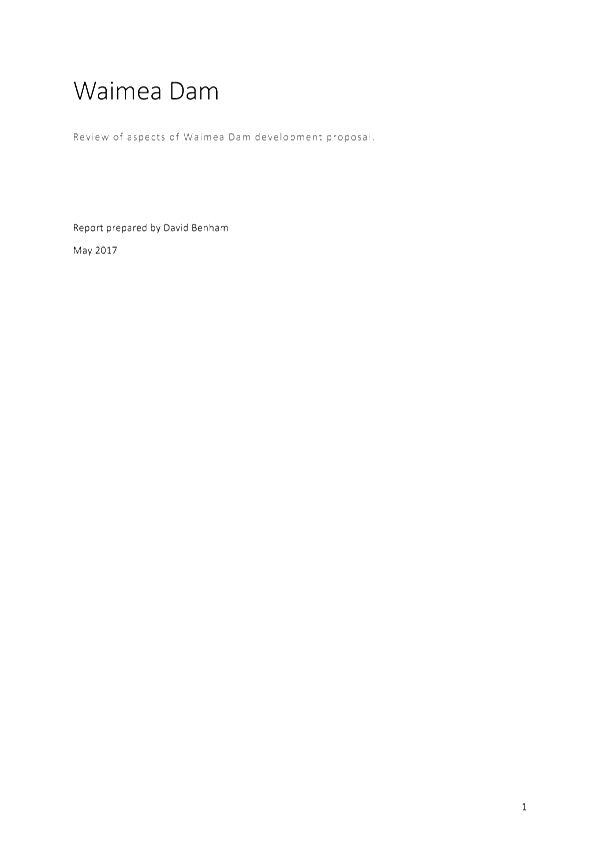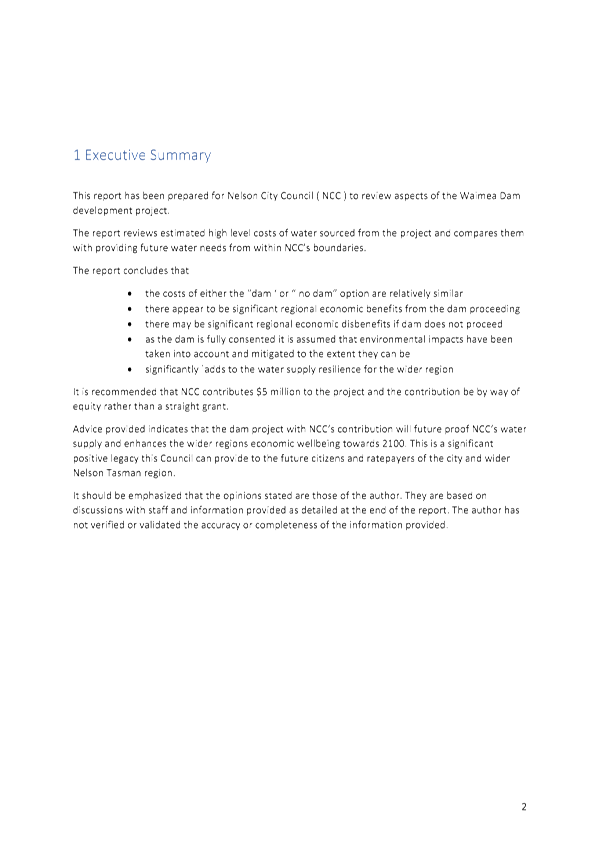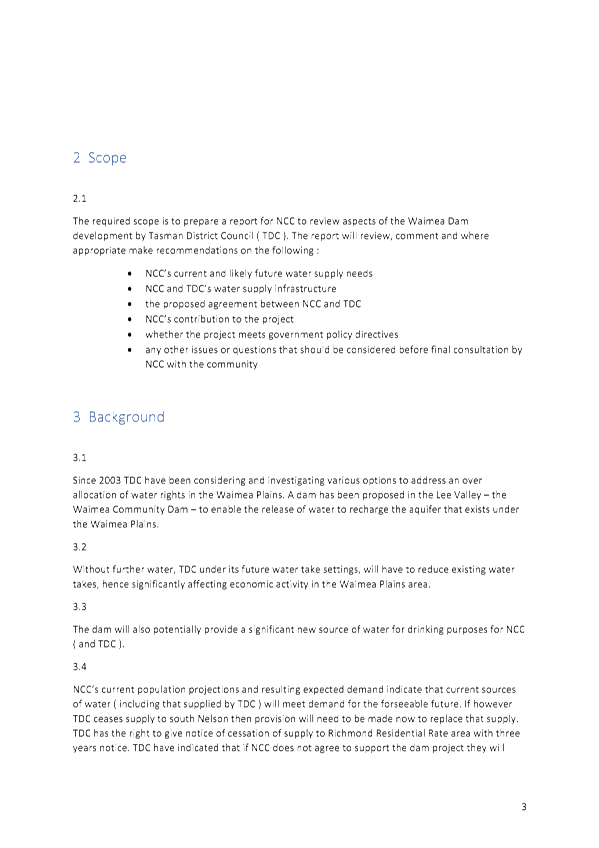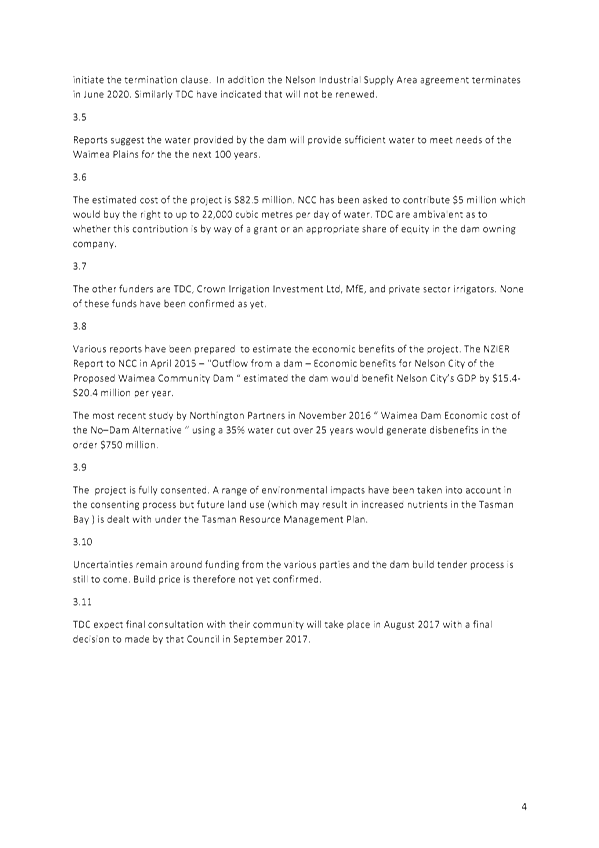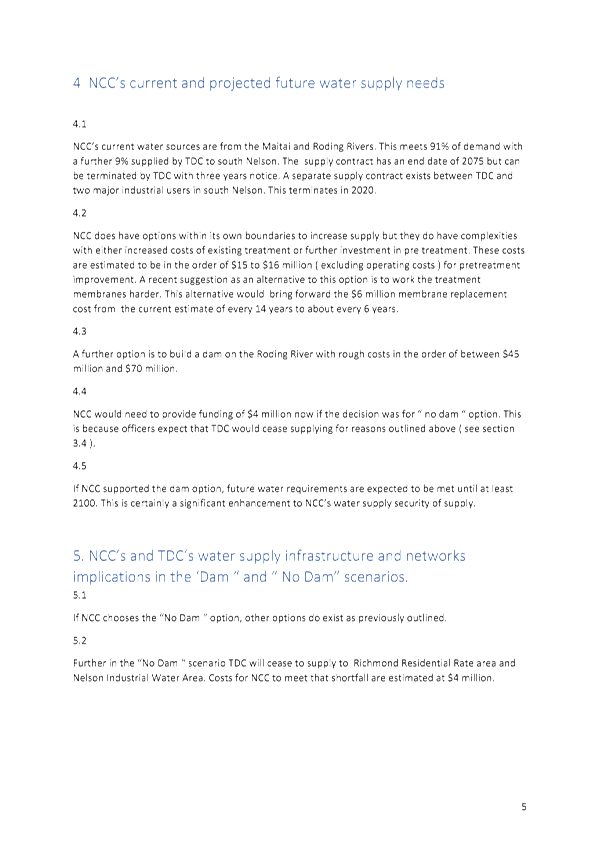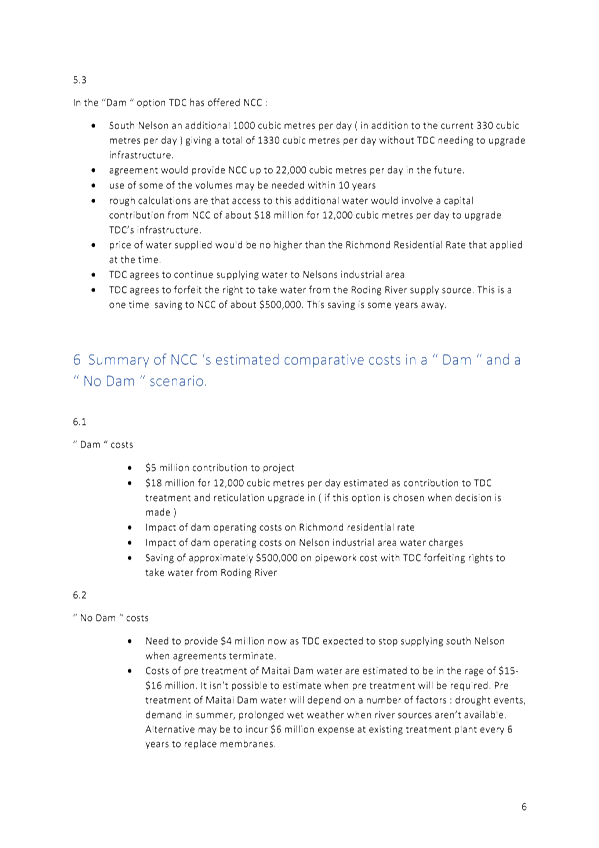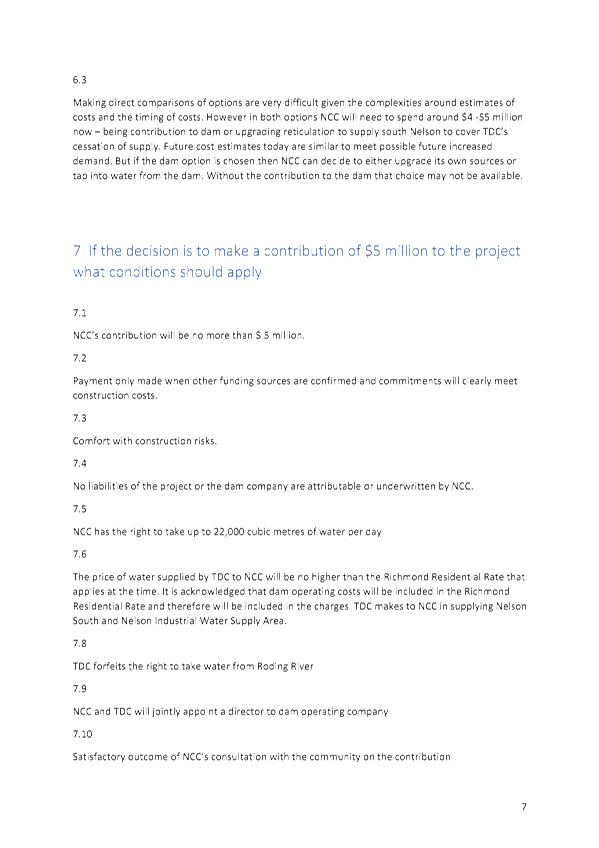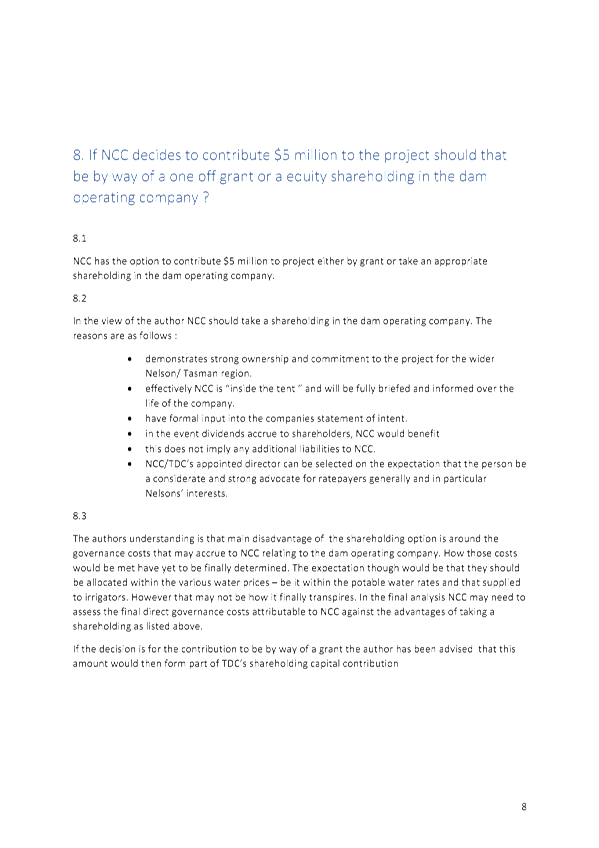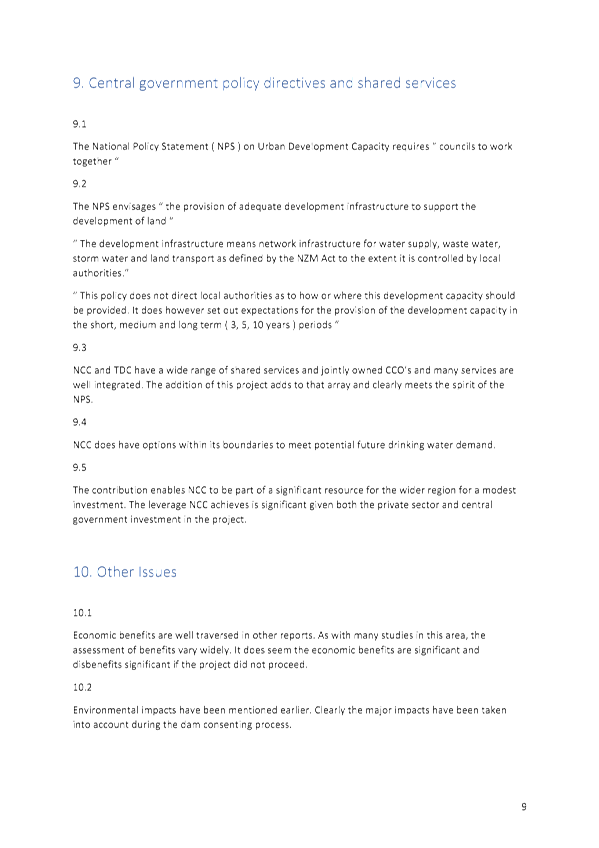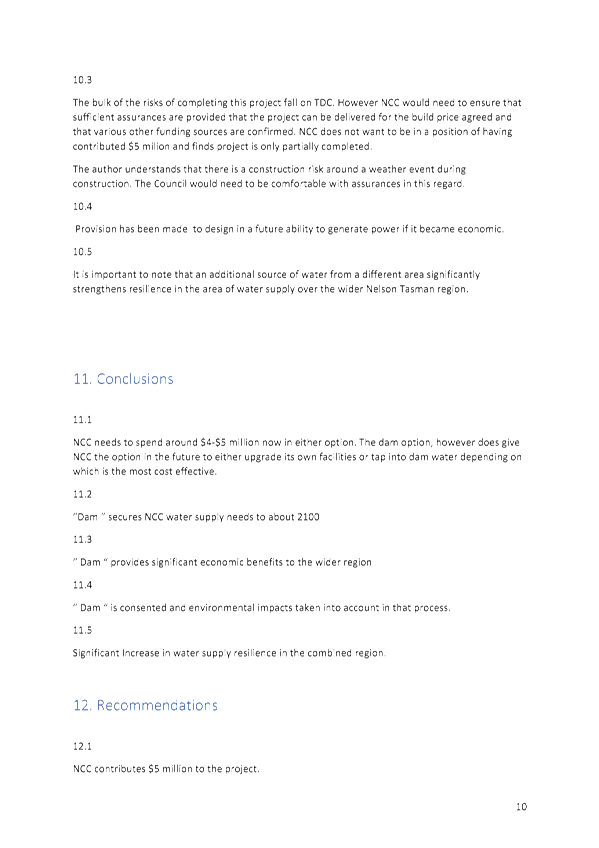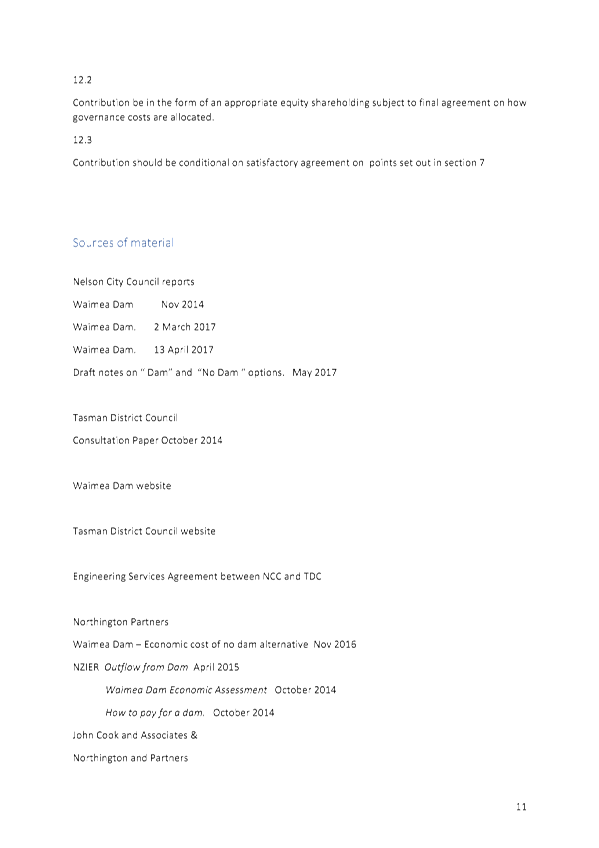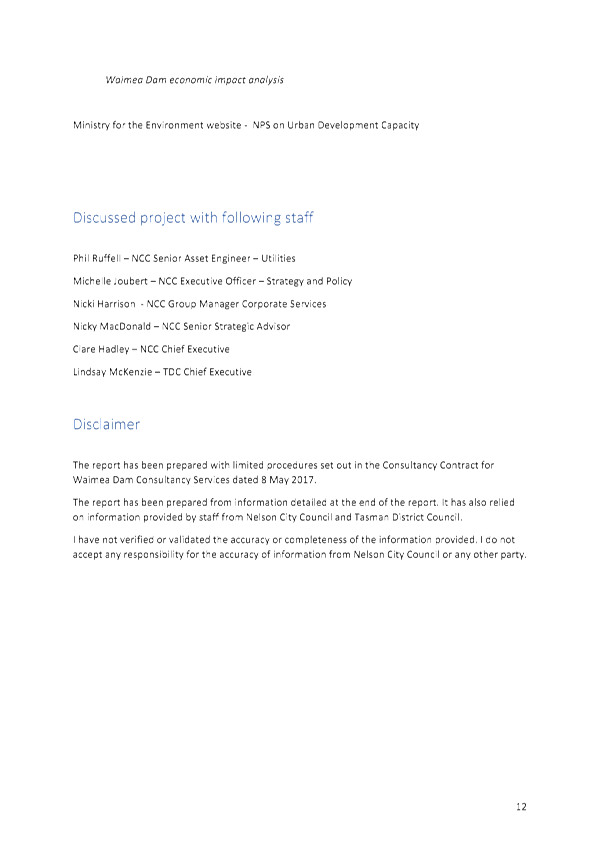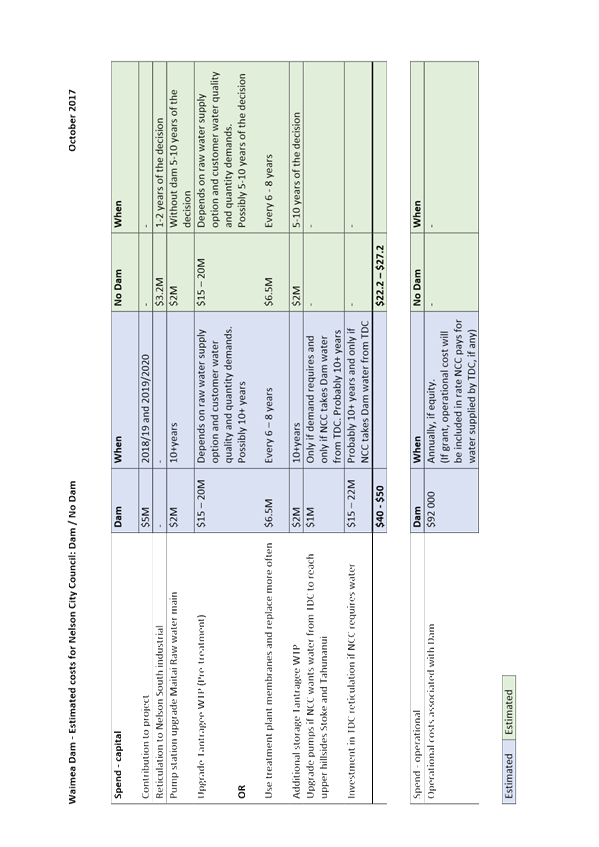|

|
Council
18 October 2017
|
REPORT R8209
Brook
Waimarama Sanctuary Trust
1. Purpose
of Report
1.1 The
purpose of this report is to consider the Brook Waimarama Sanctuary Trust
Business Plan 2017 to consider release of the remaining Annual Plan committed
funding. The report also considers the basis for a longer term relationship
between the Trust and Council.
2. Summary
2.1 The
Trust holds a 33-year lease for approximately 711 Ha of Council owned land. The
Sanctuary aims to restore native birdlife to pre-European levels which requires
considerably more than a trapping regime to eliminate pests to that level.
2.2 The
council has committed $1.688 million to the Sanctuary to date and has agreed to
that overall vision.
2.3 Council
received the updated Trust Business Plan and after a process of discussions and
updates, the Business Plan is being presented to Council with staff more
comfortable with the final form.
2.4 The
report recommends the release of the additional $150,000 funding in 2017/18
subject to grant conditions but does not commit to future years’ funding
without a broad Memorandum of Understanding (MoU) which re-sets the future
relationship between Council and Trust.
3. Recommendation
|
That the Council
Receives the report Brook
Waimarama Sanctuary Trust (R8209)
and its attachments (A1826815; A1826781); and
Approves
the revised Brook Waimarama Sanctuary Trust’s Business Plan and agrees
to release the remaining $150,000 for 2017/18 to the Trust contingent on:
(a) The Trust supplying Council
annually, by August each year, with respect to their Business Plan and
six-monthly updates on cash flows in July and January of each year;
(b) A Memorandum of Understanding be
developed and agreed by full council prior to any future funding commitments
being made.
Agrees
that the Dun Mountain walkway damaged as a result of the major slip needs to
be reinstated to a minimum width of 1.5m to maintain a route for cyclists and
pedestrians, noting that the Brook Waimarama Sanctuary Trust has agreed to
reinstate this track to that standard at their cost.
|
4. Background
4.1 The
Trust has completed the Sanctuary fence on, in places steep terrain requiring
an ongoing investment into fencing maintenance and repair.
4.2 The
completion of the fence was officially opened by the then Prime Minister the
Honourable John Key.
4.3 Council
as part of the 2017/18 Annual Plan process resolved as follows:
Council
Meeting on 23 May 2017
“Sets
aside a budget of $250,000 for Brook Waimarama Sanctuary Trust activities with
only $100,000 being paid to the Trust at this time and applications for further
funding from this provision being referred to the Planning and Regulatory
Committee”.
Planning and
Regulatory Committee on 27 July 2017
“Refers
to Council all powers of the Planning and Regulatory Committee relating to the
Brook Waimarama Sanctuary Trust applications for further funding from the
provision set aside in the Annual Plan 2017/18”.
4.4 This
report traverses issues covered over several committees and focusses on the
future relationship between Council and Trust. Therefore it has been taken
directly to Council.
4.5 An
agreement is in place with the Trust for the $100,000 for this year.
4.6 The
Trust has submitted a revised Business Plan to justify the additional
$150,000.
4.7 The
Trust has commenced the brodifacoum bait drop following a legal challenge from
the Brook Valley Community Group that progressed to the Court of Appeal. That
request for a stay was not granted but the Appeal is still active.
5. Issues
5.1 The
following represent the key issues in this report:
· The Trust needs the
further operating grant to be released. Officers’ view is that the Trust
has fulfilled the extent of the grant conditions
· Council assesses that
there is risk to its sunk investment, particularly to the Trust’s
financial position needing ongoing council support, and also reputational risk
· The need to change the
basis of relationship between the Trust and Council reflective of the growing
investment and need of Council to effectively mitigate risk
6. Discussion
6.1 The
following is broader discussion on key related matters with the Sanctuary:
Slip
issues
6.2 There
have been a number of slips around the sanctuary during the construction of the
Trust’s fence and since the fence has been completed.
6.3 The
most significant slip affected the Dun Mountain Trail. This slip occurred on
the 7 March 2015 and caused damage to the fence platform cut by the Trust and
approximately 90m of the Dun Mountain Trail at the top of the head scarp.
6.4 The
fence bench was cleaned by the Trust and the Dun Mountain trail was made safe
with temporary fencing, with costs shared 50/50 between Council and the Trust.
The Trail was re-opened to cyclists and pedestrians on 23 April 2015.
6.5 The
issue is very complex and involves Council from two perspectives - as landowner
and as regulator.
6.6 Officers
and the Trust, through several meetings and discussions, have been working
through how the slip should be remediated and who should be responsible for the
remediation costs. The Trust’s own specialist geotechnical engineers,
Nelson Consulting Engineers (NCE) dated 28 April 2015 concluded:
“Though
the rainfall event was the trigger mechanism, the predominant cause of
the slip was the construction of the fence line track which undermined the
slope above”. ……… “Siting the fence line track
significantly downhill and further away from the walkway may have possibly
reduced the risk to the walkway but at the same time caused more severe
instability problems to the fence line track at greater cost”.
6.7 That
NCE report proposed five conceptual remedial possible solutions with a maximum
cost noted of around $90,000.
6.8 Following
another rainfall event on 15 February 2016, the same slip was further affected
resulting in damage to the Trust’s fence platform and damage to
approximately 100m of fence and causing the Dun Mountain Trail to drop by about
2m. The Trust reinstated the fence. Refer to Attachment 2 for photos of the
slip pre and post remediation of the fence.
6.9 Officers
and the Trust have continued to meet to try and find a
solution.
6.10 The
Trust provided a further report to officers on 23 August 2016, making the
argument that whilst the slip was regrettable and unfortunate, from a
historical preservation perspective, that the Trust should not have to
reinstate the slip to full vehicle access on the basis that alternative
vehicular access was available via other routes. The Trust also provided evidence
of their consultation noting agreement from those consulted that full vehicle
access was not required.
6.11 Following
a further report from the Trust’s geotechnical specialist on costs to
reinstate the Dun Mountain Trail to allow vehicular access and a combined site
visit on 13 September 2016, officers commissioned an independent geotechnical
investigation on the slips. That report, received on 9 November 2016,
concluded:
· That the slippage above
the fence appears to have stabilised but that the side scarp and head scarp
(affecting the Dun mountain trail) will continue to fritter away;
· That slippage below the
fence does not appear to have stabilised and could undermine the fence;
· That any remedial
solution would be in the order of $200,000 not the $99,000 suggested by NCE.
6.12 Following
a joint meeting with the Trust’s and Council’s consultant on 2
August 2017, it was noted that doing nothing (i.e. adopting a managed retreat
policy) of the head scarp will lead to the loss of the Dun Mountain walkway in
two to five years’ time. Council’s consultant noted that the only
option to prevent this would be to construct a pole retaining wall (to maintain
the absolute minimum width).
6.13 A
letter received from the Trust dated 23 August 2017 confirms that ongoing
frittering of the head scarp will be an issue. The Trust also acknowledges that
reinstatement to a walk/cycle width is appropriate and that this will be at the
Trust’s cost.
6.14 Council
officers’ estimate this work at between $250,000 and $300,000 (including
design, administration and consenting). The Trust is seeking an estimate from
its consultant, but it is noted that it has an amount of $184,000 in its
current cash flow for this work which officers deem to be on the light side.
6.15 Officers
are awaiting feedback from the Trust and its geotechnical engineer on a revised
cost estimate.
6.16 From
a purely engineering perspective, reinstatement of the track to what was there
before to cater for vehicle access is not only a very costly exercise, but
would involve a major construction exercise with substantial work to the head
scarp. If undertaken this will be a very complex reinstatement with a high
likelihood of cost overruns. It is not deemed a realistic option by officers as
both the risk and cost are unacceptably high.
6.17 Officers
support a reinstatement width of no less than 1.5m.
Regulatory Matters
6.18 Council’s
regulatory team has consistently advised that remediation of the slips was an
action for the Trust, given there were breaches of the consent conditions for
which it is the consent holder. The question as to what standard the
asset (being the trail) was to be reinstated was for the Council as landowner
to determine. There have been ongoing discussions and correspondence with
the Trust regarding breaches of the consent conditions. The question as
to what standard remediation should be set at was an issue that was intertwined
with the non-compliance matters.
6.19 In
early August 2017, the Group Manager Strategy and Environment wrote to the
Trust requesting evidence from a suitably qualified engineer that:
(a) All
necessary remedial action has been undertaken to help prevent any further
frittering away/erosion in the location of the slips; and
(b) Where
further work is identified then the necessary work is completed within a
specified time.
6.20 A
response has been received from the Trust indicating further works, in the form
of a retaining wall and removal of trees and soil, are necessary to address the
matters identified in (a) and (b). The Trust has indicated the works will
be undertaken during the summer. The regulatory team will be following
this through to ensure these actions are undertaken to achieve compliance with
the consent conditions and to remediate any further adverse effects.
Options
to address track reinstatement
6.21 The
options for the Dun Mountain Trail reinstatement to a walk/cycle width include:
· Reinstatement by the
Trust;
· Reinstatement by
Council;
· No reinstatement –
This option runs the risk of the Dun Mountain disappearing in a short period
and will result in major reputational damage. Any decision to adopt a managed
retreat policy would need to be clearly articulated to the general public and
users of the Trail. Work would include formalising temporary fencing, excellent
communications and a plan post loss of the trail.
6.22 Regardless
of which of these options is confirmed the remediation outlined in paragraph
6.20 will be required to comply with the resource consent.
Risks of the slip
6.23 The
risks that this slip poses for both the Council and Trust are:
· Reputational – a
number of the public who don’t support the fence are awaiting
reinstatement.
· Risk of another slip
that damages another section of this track and the precedent any decision on
this slip will set for future slips.
6.24 Officers
support the Trust undertaking this work to a walk/cycle width (minimum width of
1.5m).
Business Plan and Cash Flow
Forecasts
6.25 Officers
have reviewed the revised Business Plan and cash flow from the Trust. The
revised Business Plan is appended in Attachment 1.
6.26 It
is clear that the Trust will need financial assistance from the Council going
forward and that its success depends on this.
6.27 The
Trust has a conservative plan for major capital works going forward. However
the implementation of these works are very heavily dependent on the success of
income from patronage (once the poison drop is complete) as well as potential
operational costs that may arise from the likes of damage to the fence bench
(from slips) and to the fence.
6.28 If
operational costs are high as well as ongoing, then this will be at the expense
of capital projects. That is in itself not a major concern for officers.
6.29 In
addition to this, however, if operational costs are high the Trust will need to
look very hard at reducing general operational expenses and the Trust, in
meetings, accepts this.
6.30 On
balance officers are of the view that the Trust has taken on the concerns
raised by them and that the revised Business Plan and cash flow does address
all technical concerns including the need to plan for future slips and repairs
and to plan for sound asset management. Officers have given advice on some of
the amounts in the cash flow which the Trust, in the main, has taken on board.
6.31 The
Trust has made no provision for funding depreciation for their major assets
including the fence which has a life of about 30 years. It is simply unable to
do this at this time and Council should keep a watch on this going forward.
6.32 Officers
are of the opinion that the Trust be required to:
· Submit a revised
Business Plan annually;
· Submit a cash flow every
six months.
6.33 In
addition Council needs to consider whether it will give the grant in the
context of the responsibilities for the slip restoration works not yet resolved
and Council’s regulation requirements not yet met.
Ongoing relationships
6.34 The
discussion in this report has highlighted considerable risk and complexity of
the project.
6.35 Council
has viewed its roles as land owner, regulator and grant funder (with
conditions) to date. Other funders call on the due diligence that council
undertakes for their own decision-making.
6.36 The
Trust can appoint up to 15 trustees. In Clause 6.1, four organisations have
rights to appoint four of the 15 positions: Nelson City Council, Department of
Conservation, “the six iwi affiliated to Whakatu Marae”, and NMIT.
Nelson City Council does not have an appointed position. NMIT and Doc have
withdrawn their appointees after signing a MoU. The Trust may be seeking a MoU
with iwi also.
6.37 It
is not clear whether the Trust has approached Council to ask for their
appointee each time a vacancy comes up, although the Trust notes that the NCC
could take up their seat at any time they wish.
6.38 In
the Business Plan the Trust is seeking a further $250,000
in 2018/19, $150,000 as an ongoing
commitment. As the Sanctuary continues to progress and call on Council funding
Council needs to determine whether the investment and the risk lead it to a
different relationship than simply grant funder.
6.39 From
a Trust perspective the main risks have been identified (pp. 9-11 of the
Business Case):
· Predator removal is
unsuccessful (Low likelihood)
· Significant failure of
the fence (Moderate likelihood)
· Loss of public support
(Low likelihood)
· Financial viability (Low
likelihood)
· NCC does not support the
Trust (Low likelihood)
· NCC discontinues annual
funding (Moderate likelihood)
· Brook Management Plan
delays (Moderate likelihood)
· Social cost to the
community of not advancing the Sanctuary (Low likelihood)
6.40 From
a Council perspective the Sanctuary is a key project with $1.688 Million of
ratepayer’s money committed to the project. Council would identify
similar risks as the Trust but may elevate the significance of some risks from
its perspective – the risk of financial failure, regulatory failure, and
reputational risk.
6.41 The
Trust is concerned about its financial challenges including not funding
depreciation at this stage, not being proactive for some time to address the
slip, and there could be many more such slips on a challenging landscape. NCC
is an obvious funding partner for this kind of financial challenge and may well
be locked in to a long term funding arrangement to ensure the Trust’s
financial sustainability.
6.42 The
project is still in the development phase. The next phase after the brodifacoum
drops will see the increase of bird life and revenue earned from a tourism
opportunity. Sufficient commercial tourism skills will be required on the
Trust. Council’s role as funder will likely change.
6.43 Reputational
risk would emerge if the Trust did not adhere to the regulatory conditions of
the brodifacoum drop – those conditions being largely monitored by
council’s regulatory functions – a loss of reputation with the
community, or as landowner, Council became embarrassed by the way in which the
Trust treated Council’s neighbouring landowners.
6.44 Depending
on how Council views these risks and its future commitment of funding to the
project, the range of actions could be:
· Remain a grant funder
and manage risk with conditions of the funding
· Place an appointee onto
the Trust with specific skill sets
· Develop an MoU with the
Trust which establishes the basis for the relationship moving forward, covers
regulation issues, governance, accommodates the relationship with other
funders, reputational needs of Council and other.
7. Options
7.1 Several
options are discussed below.
|
Option 1: Remain a grant
funder with grant conditions
|
|
Advantages
|
· The
easiest and least time consuming role
· Autonomy
for the group to operate
|
|
Risks and Disadvantages
|
· Council’s
investment in the Sanctuary grows and the risk may grow also
· Grant
conditions are a blunt tool for working through a longer term relationship
· Council
is the landowner and has landowner responsibilities with neighbours and the
wider community, so can’t leave these relationships entirely to a
lessee
|
|
Option 2: Place an appointee
onto the Trust
|
|
Advantages
|
· The
Trust Deed allows Council to appoint one person as trustee, alongside
appointees from three other organisations
· A
better link to Council and its investment
· More
confidence in governance over a large investment
|
|
Risks and Disadvantages
|
· Perception
of conflict of interest with Council’s role as regulator
· The
Trust already has a large number of trustees (15 are permitted) and the voice
of the council appointee may get “lost in the crowd”
· NCC
raises the reputational risk to itself by direct involvement in governance in
an environment where it could affect little change if it needed to
· NCC
has a position of not placing its members onto Boards where they can carry
liabilities for those Boards
|
|
Option 3: Develop a broader
MoU
|
|
Advantages
|
· A
more relational approach with the Trust which also builds in expectations
from Council
· A
natural progression as public funding increases
· Advantage
to the Trust of an understood relationship with council as a strategic
partner
· Maps
out an agreed pathway to change if required
· Canvasses
more topics than grant funding conditions including regulatory
responsibilities and payment for slip works
|
|
Risks and Disadvantages
|
· Appointee
risks as noted in Option 2
· With
an MoU Council raises its role as a stakeholder in the Sanctuary and
expectations from the community of that role
|
8. Conclusion
8.1 As
well as grant conditions being sought on the release of the full 2017/18
funding, it is recommended to enter into a broad MoU which addresses regulatory
issues, repair of the slip, future Trust governance matters, financial input
from council, reporting and communication protocols, public communication and
notification processes and other as deemed necessary by Trust or Council.
David
Hammond
Acting
Chief Executive
Attachments
Attachment 1: A1826815
- BWST - Business Plan ⇩
Attachment 2: A1826781
- BWST - Fence Slip ⇩
|
Important considerations for decision making
|
|
1. Fit
with Purpose of Local Government
The decision required by this
report involves Council balancing affordability with the need for good
quality local infrastructure as required by section 10 (1) (b) of the Local
Government Act 2002. This clause of the Act requires Council to meet the
current and future needs of communities in a way that is most cost effective
for households and businesses.
|
|
2. Consistency
with Community Outcomes and Council Policy
Our Community Outcomes state -
“Our communities should have access to a range of social, educational
and recreational facilities and activities”. The Sanctuary and the
reinstatement of the track will addresses this.
|
|
3. Risk
The risk of Council not
providing funding could impact on the BWST’s existence. The risk of the
Dunn Mountain walk/cycle way not being reinstated could result in
reputational risk.
|
|
4. Financial
impact
The BWST has requested funding
of $250,000 for this year and next year and $150,000 going forward. This has
an impact on rates.
|
|
5. Degree
of significance and level of engagement
This is not a significant
decision in terms of Council’s Significance and Engagement Policy.
Consultation has been ongoing with the BWST on issues relating to the slip
and their Business Plan.
|
|
6. Inclusion
of Māori in the decision making process
Māori have not been
consulted on matters in this report.
|
|
7. Delegations
This reports covers a number of
issues covering several committee delegations. Bringing this to full Council
is appropriate.
|
|

|
Council
18 October 2017
|
REPORT R7634
Waimea
Dam: Community Consultation on a Possible Nelson Contribution
1. Purpose
of Report
1.1 The purpose of this report is to:
1.1.1. Outline the value proposition for Nelson to contribute
to the Tasman water augmentation project (Waimea Dam).
1.1.2. Approve the Statement of Proposal for the possible
contribution by Nelson City Council (NCC) to the project.
2. Summary
2.1 Water rights are over-allocated on
the Waimea Plains. A dam in the Lee Valley is proposed to provide water for the
Waimea Plains, industrial and residential areas. It is expected that this will
provide water security for the Nelson Tasman region for the next 100
years.
2.2 It is estimated the project will
cost $75.9 million ($82.5 million including expenditure to date of $6.58
million) and it is proposed to be funded by the public and private sectors. The
Waimea Dam project (the Dam) has the potential to deliver regional economic
benefits and, by providing an extra water source, to also improve regional
resilience.
2.3 It is not the role of this report
to consider again the years of assessment and analysis which resulted in the
proposal to build a regional dam. However, it does describe the
background to the project and NCC’s involvement to date. The evidence for
regional economic benefits which will provide value to Nelson is outlined. The
report also considers Nelson’s future water needs both for the city as a
whole and the Nelson South area which has historically been supplied with water
by Tasman District Council (TDC). Most of the environmental benefits and
negative environmental consequences impact in the TDC area so these are not
explored in depth. Finally, the report assesses the options for an NCC
contribution via a grant or purchase of equity.
2.4 Support for the Dam project would
be consistent with Nelson City Council’s approach of principle over many
years, to work collaboratively with partners to ensure the best outcomes for
the whole region.
2.5 It is recommended that a special
consultative procedure is undertaken to ensure an appropriate level of
community engagement in the Council’s decision. A draft Statement of
Proposal has been prepared for Council’s consideration and is in
Attachment 1. (Final comments from the legal advisors are awaited; any changes
required will be tabled on the day of the meeting.)
Assumptions
2.6 This report includes a number of
assumptions as follows:
2.6.1 The total cost of the Dam project will be at or
below $82.5million (including expenditure to date).
2.6.2 Funding will be received from TDC, Waimea
Irrigation Limited (WIL), Crown Irrigation Investments Limited (CIIL) and a
Central Government grant from the Freshwater Improvement Fund.
2.6.3 If NCC contributes to the project, a new
Engineering Services Agreement (ESA) between NCC and TDC will be entered into.
A copy of the proposed Terms of the new Engineering Services Agreement, is in
Attachment 2.
Recommendation
|
That
the Council
Receives the report Waimea Dam:
Community Consultation on a Possible Nelson Contribution (R7634) and attachments (A1846450,
A1847401, A1761653, A1847397, A1766322, A1382534, A1769513; A1840371); and
Agrees
that a contribution to the Waimea Dam project of $5 million (in addition to
the $413,000 contribution to date) is Council’s preferred proposal on
which to consult the community; and
Agrees
that any contribution from Nelson City Council to the Dam project will be as
a grant rather than a purchase of equity in the Dam; and
Notes
that any Nelson City Council contribution will be made on the basis of the
proposed Terms of the new draft Engineering Services Agreement (A1847401), as
detailed in an exchange of letters between the chief executives of both
councils;
Approves
a Statement of Proposal (A1846450), with any necessary
amendments, for the possible contribution by Nelson City Council to the Waimea
Dam project.
Authorises
the Mayor and Chief Executive to make minor changes to the Statement of
Proposal.
|
4. Background
Council’s involvement
4.1 Over the last few years NCC has
made submissions to TDC supporting the Dam, including TDC’s Long Term
Plans, funding and governance options consultation, Tasman Resource Management
Plan changes and the Dam Resource Consent Application.
4.2 As a financial proposal for the Dam
had not been detailed when the NCC Long Term Plan 2015 – 25 was prepared,
NCC did not allocate funding but included a comment that “headroom for
the debt associated with a possible contribution has been allowed for in
2018/2019 to align with the construction phases should the dam proceed”.
4.3 Only 20 submissions were received
on this topic at that time. The issues raised by submitters included
support from irrigators in Tasman, some opposition to contributing to a project
outside of the city, and concern that the Dam would not benefit Nelson
residents. Other submissions mentioned concerns over the environmental effects
of the Dam and some submissions commented on the regional benefits that the Dam
is expected to provide.
4.4 To date, NCC has contributed
$413,000 to the project. The $413,000 has been taken from operating expenditure,
but loan funded.
4.5 The last full report on water
matters was made to Council in November 2014. That report set out matters
relating to water takes from the Roding and Maitai Rivers, the Waimea Dam and
the Engineering Services Agreement between NCC and TDC.
4.6 Since then, Council has received
presentations from TDC and irrigators on the proposed Dam. The Mayor and
officers have also attended meetings with TDC, CIIL and WIL to keep up-to-date
with the project. A list of the key parties to the project is in
Attachment 3. There have been a number of briefings this year, to inform
councillors, and joint workshops with TDC.
Consultation Process
4.7 The decision on a contribution to
the project has long term implications for the regional economy and is a matter
which will generate wide public interest. The decision is sufficiently
significant to require a consultation using the special consultative procedure.
Following approval by Council, the Statement of Proposal will be released to
the public for feedback through the consultation period which will run from 24
October to 24 November 2017. Submitters who wish to speak directly to Council
will have the opportunity to do so at hearings on 7 December 2017 (including an
evening session) and, if needed, 11 December 2017.
Project background
4.8 Over-allocation
of water rights on the Waimea Plains has led to the situation where the Waimea
River can run dry over summer months and during these times salt water from
Tasman Bay can migrate through the aquifers and threaten coastal
wells. The shortage of water over the summer period also results in
water rationing most years.
4.9 New provisions in the Tasman
Resource Management Plan (TRMP) which will apply if the Dam is not built,
require a reduction (25 – 50%) in irrigators’ water allocations and
stricter rules for urban water supplies, including commercial and industrial
users. New rationing rules will mean more frequent and more severe
restrictions. Further details in relation to the TRMP water rationing provisions
are set out in Attachment 4.
4.10 Nelson
ratepayers will be affected by the changes to the TRMP and new water
restrictions as TDC currently provides water to properties in Nelson South and
businesses in the Wakatu Industrial Estate.
4.11 To
respond to the over allocation issue, TDC facilitated the establishment of the
Waimea Water Augmentation Committee (WWAC) in 2003 to look into options to
resolve the issue.
4.12 WWAC commissioned consulting engineers Tonkin
and Taylor Limited to review options for the augmentation of water flow to the
Waimea Plains. A number of options were considered and then ranked through an
iterative process that left the construction of a water storage dam on the
upper reaches of the Lee River as the preferred option to address the water
supply issue.
4.13 Resource consent for a dam with capacity of
13.4 million cubic metres was granted in 2015 and is now held jointly by TDC
and the Waimea Community Dam Ltd. (In comparison the Maitai Dam holds 4
million cubic metres. The Maitai Dam provides for business and residential
needs, rather than for irrigation).
4.14 The Dam will release water to the river
network to allow recharging of the Waimea Plains aquifers. A summary of the
details on the proposed Dam is in Attachment 5.
4.15 Funding for the project to date has come from
a variety of sources including Central Government, TDC, Fish & Game and
irrigators. As mentioned, NCC has contributed $413,000.
4.16 A number of governance options for the Dam
have been proposed over the last few years. The governance structure is
the subject of TDC’s consultation which is to run concurrently with
NCC’s. At present the proposal has the establishment a Dam Company (Dam
Co) that would be a Council Controlled Organisation with TDC and WIL (and potentially
NCC) as partners.
4.17 Central Government has approved financial
support to irrigators through CIIL and a grant to TDC from the Ministry for the
Environment’s Freshwater Improvement Fund.
4.18 The construction work has been tendered but tenders
are still to be evaluated and awarded. TDC needs to consult on and decide how
its share of the project will be funded, which will require an update to its
Revenue and Financing Policy.
4.19 TDC included $25 million in its Long Term Plan
2015-2025. TDC will not finally commit until it has agreed an acceptable
investment proposal and tender price, has consulted on the proposal (including
to form a CCO) and has confidence that the other parties are able to commit
their capital and meet their share of the operating costs.
5. Summary
of advantages and disadvantages for Nelson
5.1 The
following is a summary of the main advantages and disadvantages that support
for the project will generate for Nelson:
|
Advantages for Nelson
|
|
Improved security of supply to
Nelson South industrial users that are currently and may in future be
supplied by TDC.
|
|
Estimated total capital
investment of $3.2 million in the NCC network to supply water from the NCC
network to industrial users in Nelson South may not be required.
|
|
Potential to access an
additional water source of up 22,000 m³/day (reduced in times of severe
drought).
|
|
Potential to delay scheduling a
project to introduce pre-treatment of the Maitai Dam water (or, to achieve
the same objective, renew treatment membranes more regularly).
The estimated cost of
pre-treatment is $15 - 20 million (the lower end of this range would require
using aluminium chlorohydrate) and the cost of replacement of membranes is
estimated at $6.5 million every 6 – 8 years depending on the extent to
which the Maitai Dam water is used. The price of membranes will be subject to
changes in the exchange rate.
|
|
Regional economic growth.
|
|
An additional water source
increasing the resilience of the Nelson Tasman regional water supply
|
|
Disadvantages for Nelson
|
|
Cost of the capital
contribution increasing pressure on rates and debt.
|
|
If Nelson requires access to
the additional water (above the 1000 m3/day for Nelson South) in future, a
capital investment in TDC’s network to access the water and supply to
Nelson will be required. Rough estimates provided by TDC put the cost at
$1500/m³/day supplied which equates to $15 million for 10,000 m³/day
and $22 million for 15,000 m³/day.
To maximise supply to Stoke /
Annesbrook / Tahuna or further, would require an upgrade of NCC’s
network of $0.8 – 1 million for 5,000 – 10,000 m³/day.
|
|
Water obtained from TDC will be
at the more expensive Richmond Residential Rate.
|
|
If NCC purchases shares or
equity in the Dam Co, NCC will have an ongoing share of the operational costs
of Dam, with NCC’s share estimated at $92,000 per year.
|
|
Uncertainty around costs adds
risk (both around the final cost of the project and the contributions of
other partners)
|
5.2 There are also potential
environmental impacts, both positive (improved flows in the Waimea River) and
negative (increased nutrient run-off into waterways and Tasman Bay), but as
these largely accrue only for the TDC area they are not included in the table
above.
6. Discussion
Regional cooperation
6.1 Support for the Dam project would
be consistent with Nelson City Council’s approach of principle over many
years, to work collaboratively with partners to ensure the best outcomes for
the whole region. Focussing on the arbitrary division created by the border
between the two councils ignores the fact that the communities and economies of
the two districts are inextricably intertwined. Attempting to divide, on
a strict basis, the benefits from a once in a generation project such as the
Dam is not likely to capture the full regional impact of ensuring resilience of
water supply for at least the next 100 years.
Regional economic benefits
6.2 Several studies have been
commissioned on the economic effects of building or not building the Dam.
The following documents are available online and on councillors’ shared
drive:
i. Update of economic impact assessment of Waimea
Community Dam, NZIER report
commissioned by the Nelson Regional Economic Agency, July 2017, to
update its 2014 Waimea Dam Economic Assessment
ii. Waimea Dam. Economic Cost of the No-Dam Alternative.
Northington Partners, November 2016
The report
provides a summary of the potential financial and economic impacts of the Dam
not going ahead. The report was prepared by Northington Partners at the
request of WIL.
iii. Outflow from a dam. Economic benefits of Nelson City of the
proposed Waimea Community Dam. NZIER, April 2015
The report
identifies and assesses the economic and environmental consequences of the Dam
for Nelson City and Tasman separately. The report was prepared by NZIER
for Nelson City Council.
iv. Waimea Dam Economic Assessment Report. NZIER, October 2014
The report
provides information on the economic impact of the Dam on a regional
basis. The report was prepared by NZIER for Nelson Economic Development
Agency
v. How to Pay for a Dam. NZIER, October 2014
The report
considers the provision for environmental flows in the Waimea River by the Dam
and also the provision for future demand for water from irrigation, residential
and industrial growth. It weighs the cost of these provisions and suggests how
the cost might be met. The report was prepared by NZIER for TDC.
vi. Waimea Community Dam Economic Analysis. John Cook and
Associates and Northington Partners, June 2011
The report
provides an economic impact analysis of the Dam as well as the cost and
disruption to the region’s economy should the Dam not be built. The
report was commissioned by the Nelson Economic Development Agency and prepared
by John Cook and Associates and Northington Partners.
6.3 The economic value of the Dam to
the region derives from avoiding the loss of primary production that would
result from water restrictions as well as the increased production enabled
(both from existing areas and new land brought into production).
6.4 The most recent of the above
reports, the NZIER update of economic impact, reflects changes in land use and
margins for primary produce since 2014.
6.5 The NZIER report examined a
conservative assumption of water restrictions equivalent to 20% cut in
allocation, and a stronger assumption of 35% allocation cuts. The updated
analysis suggests that under the 20% water allocation cut scenario, the
estimated net benefits of the Dam over 25 years would have a present value of
$295 million and a benefit cost ratio of 6.0. This is 14% larger than the 2014
result. Under the higher 35% cuts scenario, the net benefits would be larger at
$374 million, with a benefit cost ratio of 7.4.
6.6 Economic impacts of Waimea Dam for
Tasman-Nelson region
|
Measure
|
20% allocation cut
|
35% allocation cut
|
|
Increase in GDP in first 2
years
|
$55 million
|
$55 million
|
|
Increase in GDP for each subsequent
year
|
$78 million
|
$107 million
|
NZ$ in 2013 terms; and present values over 25 years on
2013 base.
6.7 An earlier NZIER report from 2015
assessed the economic benefit for Nelson alone. In 2013 the Nelson-Tasman
region had a combined GDP of $3.8 billion, of which 2.1 billion (56%) was
attributable to Nelson City. The value to Nelson City of activities flowing in
from the Waimea Plains was estimated to be between $14.8 million and $18.4
million per year.
6.8 Without the Waimea Dam, if there
are 20% or 35% cuts in water allocation, Nelson City would lose $4 million or
$9 million respectively in annual GDP. The Waimea Dam would avoid those losses
and enable increased production on the Plains, with flow on effects to Nelson
City of $11.4 million per year. On these estimates the Dam would benefit Nelson
City’s GDP by $15.4 - $20.4 million per year.
6.9 As the updated 2017 NZIER report
found greater benefits than in the 2014 assessment, it can be expected that the
size of the financial benefits to Nelson would have increased proportionately.
Nelson’s
long term water needs
6.10 Council’s long term water planning was
reviewed as part of the process of developing the Long Term Plan 2015-2025, the
supporting Water Supply Asset Management Plan 2015-2025 and the 30 year
Infrastructure Strategy.
6.11 The objective for Council’s water assets
is to “provide a water supply to Nelson City that is capable of
abstracting, treating and distributing potable water in an efficient, safe,
reliable and sustainable way whilst ensuring that the ecological, recreational
and cultural interests of the community in the water sources are recognised and
enhanced.”
6.12 A summary of the water supply activity is that
NCC supplies high quality water to Nelson households and businesses from two
sources, the Maitai (North Branch Dam and South Branch weir) and Roding
Rivers. The replacement value of assets, including pipelines, reservoirs, pump
stations, the treatment plant and dams was valued at $249 million as at June
2016.
6.13 Council abstracts between 7.2 and 8.5 million
cubic metres of water a year from within Nelson boundaries.
Nelson’s average daily peak demand is approximately 26,000 m³/day
– 28,000 m³/day. The Nelson Water Treatment Plant has the capacity
to treat 50,000 m³/day. In order to supply this volume to the plant the
pump station on the duplicate raw water pipeline will have to be upgraded at a
cost of approximately $2M and an additional storage tank installed at the
treatment plant also at a cost of approximately $2M.
6.14 It is more economical to use water from the
two river sources rather than the Maitai Dam as water from the rivers requires
less treatment and therefore puts less pressure on the membranes at the Water
Treatment Plant. A trial in late 2016 of using only water from the Maitai Dam
for supply was required to be cut short because of problems with discoloured
water and subsequent complaints from users. The higher level of organic
matter in the Maitai Dam water also stressed the older membranes at the Water
Treatment Plant.
6.15 The trial suggests that to rely on meeting
Nelson’s water needs from the Maitai Dam, NCC would need to invest in
pre-treatment of the water to reduce the level of organics or accept a reduced
service life of the membranes and increased replacement costs. More work is
needed to fully understand what costs NCC might face if it chose to use more water
from the Maitai Dam.
6.16 The cost of pre-treatment was previously
estimated at $17 - 20 million. Independent experts have been contracted
to do further work and have provided a revised estimate of $15 – 16
million. The new estimate is based on the use of aluminium chlorohydrate
as coagulate (rather than ferric chloride). Concerns were raised in the
past by the community in relation to the perceived health risks connected to
the use of aluminium chlorohydrate.
6.17 An alternative to pre-treatment is to accept
more regular replacement of the membranes (and
possible water discolouration, depending on the outcome of work described in
6.19 below). There are five trains of membranes at the plant and each
costs approximately $1 million to replace at the current exchange rates.
The estimated cost of replacement of the membranes is approximately $6.5
million every 6 – 8 years depending on the extent to which the Maitai Dam
is used. Some of the current membranes are 14 years old having performed much
better than predicted by the manufacturer. The fifth train membranes were newly
installed in 2016/17 and two sets of trains will be renewed in 2017/18.
6.18 The recommendation from the consultant’s
report is, in fact, to not pre-treat but to continue to use the membranes and
accept a faster rate of replacement. Otherwise Council could invest in
some very expensive pre-treatment assets which would sit idle except for a
relatively short period in the height of summer.
6.19 It should be noted that the cause of the related issue of water
discolouration has proven to be difficult to trace. One strong contender
appears to be more related to the pH of the water that results from the various
chemicals used to facilitate filtering of Maitai Dam water by the membranes. Changes
of pH may lead to the mobilisation of the iron and manganese that has accumulated in the pipes over many years. Officers believe that this uncertainty can be resolved by further testing and adjusting
quantities and proportions of these flocculating chemicals to provide some clear understanding of the
various factors at play. A strictly
controlled testing programme will be developed this year.
6.20 As seen from 6.13 above, Nelson does not have
any shortage of water from its current sources for the foreseeable
future. However, NCC now has the opportunity to improve the resilience of
regional supply by contributing to the Dam which is proposed to provide water
for the Waimea Plains and nearby residential areas for the next 100
years. Through its contribution, NCC would have the potential to access
an additional water source for the city of up to 22,000 m³/day, albeit at
a relatively high cost.
6.21 If Nelson requires access to additional water
in future, a capital investment in TDC’s network to access the water and
supply it to Champion Road will be required. Rough estimates provided by TDC
put the cost at $1500/m³/day supplied. This equates to $15 million
for 10,000 m³/day and $22 million for 15,000 m³/day and so on,
depending on the volume of water required.
6.22 To maximise supply to Stoke / Annesbrook /
Tahuna or further into the NCC district, pump stations would need to be
installed to get the water into the reservoirs on the hillsides. This
would cost approximately $0.8 – 1 million for 5,000 – 10,000
m³/day.
6.23 Instead of purchasing water from TDC, NCC
could extract water from the Waimea Plains aquifers on its own account by
installing its own wells, treatment and reticulation at an estimated cost of
$17 – 20 million for up to 22,000 m³/day.
6.24 Water from the Waimea aquifers has less
dissolved organic material than that from the Maitai Dam and therefore taking
water from the Waimea aquifers either through new NCC wells or via TDC, may
delay (but not eliminate) the need to commence pre-treatment of the Maitai Dam
water. On the other hand, water from TDC is already more expensive than NCC can
supply and that cost will rise once the Dam is built.
6.25 If Council routinely has to use the Maitai Dam
for more than 10 days at a time as a raw water source then a primary clarifier
to remove organic materials or more regular replacement of the treatment plant
membranes will be required. In that event, it is likely that NCC will need to
consider pre-treating the Maitai Dam water at some point in the future (or
replace membranes more regularly) regardless of whether water is being supplied
from TDC or not. To date pre-treatment has not been necessary as NCC has been
able to consistently use the river sources.
6.26 Over the last decade, NCC has on the following
4 occasions relied solely on the Maitai Dam as a water source for more than 10
consecutive days: April /May 2007 for 20 days, August 2008 for 16 days,
February / March 2015 for 32 days (valve maintenance) and April /May 2016 for
50 days (trial). The Maitai Dam was used as the only source for the
highest total number of days in 2016 (124 days) and the lowest total number of
days in 2009 (46 days). The average number of days per year on which the
Maitai Dam was used as the only water source during the period 2007 –
2016, is 88.1 days.
6.27 Whether greater reliance needs to be placed on
the Maitai Dam will depend on a number of factors: drought events and demand
(particularly an issue in summer when the river flows are low), prolonged wet
weather when river sources are not available and events that damage river
intakes or supply lines.
Nelson South
supply
6.28 TDC supplies approximately 9% of the Nelson
water supply through an Engineering Services Agreement (ESA) for Nelson South
residents and industrial users in the Wakatu Industrial Estate. A copy of the
current ESA is in Attachment 6. TDC also has separate contracts with two major
industrial users in the area: the ENZA apple packing plant and the Alliance
meat processing plant. (Further details in relation to the Nelson South
industrial users are set out below in paragraphs 6.34 – 6.37)
6.29 Under the current ESA, the water supply is
capped at 330 m3/day and the agreement provides that TDC can give three
years’ notice to cease supplying residential users in Nelson South.
6.30 The water TDC currently supplies to Nelson
South residential is more expensive than the rate at which NCC can supply water
(details are set out in par. 6.38 – 6.41). The difference in price
is borne by all Nelson water users. The cost of water purchased from TDC is
budgeted at $250,000 per year.
6.31 As development is continuing in Nelson South,
the water demand from this area is only going to expand. In order to
secure a water supply to the Nelson South area for current residential and
industrial users and future developments, officers have discussed with TDC
proposed amendments to the ESA and the basis of a NCC contribution to the
project. The proposed Terms were discussed with the Council during the
briefing on 13 April 2017.
6.32 The proposed Terms state that in the
“with Dam scenario” up to an additional 1,000 m3/day (on top of the
330 m3/day supplied currently) would be made available to the Nelson South area
immediately and without the need for any NCC contribution to upgrading the TDC
network. This was included in the agreement to ensure that development in
Nelson South would not be restricted by water supply and so that NCC would not
have to invest extra in its reticulation to reach the new areas of development.
6.33 However, since the time the revised ESA was
negotiated some changes have occurred. As a result of development pressures in
the Saxton Area, Council has entered into a Private Developers Agreement that
provides for the Saxton residential area (existing and proposed) to be provided
with reticulated water from Nelson’s supply in the immediate future.
Provided the planned private development proceeds, the reticulation put in
place would allow expanding development in this area to be serviced by NCC at a
lower cost than purchasing water from TDC.
Nelson
Industrial Water Supply Area and ENZA and Alliance
6.34 Under the current ESA, TDC directly supplies a
number of industrial users in the Wakatu Industrial Estate. TDC also has
separate contracts with two major industrial users in Nelson South: ENZA and
Alliance. The supply to the industrial users expires on 30 June
2020. The separate agreements that TDC holds with ENZA and Alliance also
expire in 2020.
6.35 Under the proposed Terms, TDC would continue
to supply the current Nelson industrial water supply area (which includes ENZA
and Alliance). TDC would also continue the current system of contracting
with and invoicing those businesses directly. Such an arrangement would protect
NCC from having to supply large water users with water invoiced at NCC rates
but purchased at a TDC residential rate. Making up the difference between those
two rates is an estimated cost to NCC of $350,000 per year which would
potentially be borne by all water accounts.
6.36 Should the current supply arrangements
continue, NCC would be able to defer the construction of the large diameter
water mains to the industrial areas programmed for 2025-2030, at a capital
saving of approximately $3.2 million. It should be noted, however, that
industrial users have the right, at any time, to approach NCC and request it
take over supply.
6.37 Should NCC be in a position of having to take
over supply to these large industrial users it could choose to continue
sourcing that water from TDC. However, under current arrangements, the higher
water costs of TDC water would be averaged across all Nelson users to the
disadvantage of our residential users. Alternatively NCC could strike a
separate higher water rate for industrial users supplied with TDC water, but
that would be hard to justify given the bulk user rates available to industrial
users in other parts of the city.
Cost of water supplied by TDC
6.38 If the Dam goes ahead, the cost of water
supplied by TDC to NCC would increase to reflect the Dam construction and
operational costs; the Engineering Services Agreement is tied to the rate
charged for Richmond residential customers.
6.39 TDC recovers water costs through an annual
service charge plus a rate per cubic metre of water supplied.
6.40 The table below sets out the 2017/18 NCC and
TDC water charges.
|
Supplier
|
Approx.
Annual charge ($inclGST)
|
Approx.
Cost/m3 ($inclGST)
|
Volume
|
|
NCC
to customers
|
189.32
|
1.964
|
0-10,000m3/year
|
|
|
|
1.550
|
10,001-100,000
|
|
|
|
1.222
|
>100,000
|
|
TDC
to customers
|
320.33
|
2.08
|
All
volumes
|
|
TDC
to NCC residential customers
|
-
|
3.33
|
All
volumes. Annual charge included in water rate.
|
6.41 TDC Richmond residential charges are about 20%
higher than the rate at which NCC can supply water. TDC estimates that the
Richmond residential rate is likely to rise by 6 to 8% following construction
of the Dam.
Alternative scenarios in
relation to Nelson South supply – residential, industrial and ENZA and
Alliance
6.42 If the Dam goes ahead with no contribution
from NCC, the Nelson South supply from TDC would continue as per the current
ESA which provides for a three year notice period (residential) and supply to
industrial users to cease in June 2020. The separate agreements that TDC
holds with ENZA and Alliance provide for supply to cease in 2020.
6.43 It is likely, given the amount of water that
will be available, that TDC will continue to supply the Nelson South area
however this supply is likely to be at a premium cost. Once the private
developer has extended NCC reticulation to the residential area NCC may choose
to cease taking TDC supply for that part of its district as it would result in
a saving to ratepayers.
6.44 If the Dam is not built, TDC will activate a
three year notice period to cease supplying Nelson South (residential and
Nelson industrial water supply area) from the date of the ‘No-Dam’
decision. TDC will also cease supply to ENZA and Alliance from the expiry
date of their separate contracts.
6.45 The amount of supply required to replace the
water from TDC might be up to 485,000 m³/per year. While the
residential area is now expected to be connected to NCC supply by the time a
cease supply notice would take effect there would be a capital cost for piping,
currently estimated at $3.2 million, to supply the industrial area.
6.46 In addition, there would be greater reliance
on the Maitai Dam to maintain supply and it is possible, as mentioned above,
that capital expenditure of $15 – 20 million will be required to
pre-treat the water in order to protect the treatment plant membranes and
possibly reduce the incidence of discoloured water complaints.
Alternatively, more frequent replacement of the membranes estimated (at the
current exchange rate) at $6.5 million every 6 – 8 years depending on the
extent to which the Maitai Dam is used. A full business case will be
required when the decision is made in order to establish the most appropriate
course.
Roding River
6.47 TDC is entitled to receive the lesser of
909m³ per day or 1/15 of the allowable extraction from the Roding. TDC
currently takes only a small fraction of its water entitlement but NCC is
required to maintain the reticulation that TDC would use for this supply.
6.48 Under the “with Dam” draft Terms,
TDC agrees to forfeit the right to take water from the Roding River.
6.49 If the Dam goes ahead with no contribution
from NCC, TDC will retain its right to take water from the Roding River.
However this will be via an alternative point of supply and NCC would therefore
still be released from maintaining and replacing the delivery pipe. TDC
may relinquish this right once reticulation upgrades in Richmond are completed.
Meeting the National Policy Statement (NPS) on urban
Development Capacity
6.50 The NPS on Urban Development Capacity (NPS
UDC) came into effect on 1 December 2016. Its primary purpose is to ensure
councils are supplying sufficient land for urban and business use for projected
population growth; and to ensure that the supply of land is not a constraint on
housing affordability. NCC is now required to integrate infrastructure
provision with growth needs.
6.51 The NPS classifies the Nelson Urban area
(includes Richmond) as a Medium Growth Urban Area, and imposes particular
requirements on NCC. Among other things, the NPS on Urban Development
Capacity requires NCC to provide at all times sufficient residential and
business development capacity for the short, medium and long terms.
6.52 Land for industrial growth in Nelson is
limited, however Richmond West (Lower Queen Street) has always been intended to
provide for future demand and growth for business land in the Nelson Urban
area.
6.53 The uncertainty of water supply might reduce
the uptake and development of land in Richmond West and accordingly both
councils risk not meeting the NPS requirements. If the Dam does not go
ahead then the existing business and industries in Richmond West will face
water restrictions in drought years.
Environmental
impact
6.54 The Dam will result in some environmental
benefits as 30% of the Dam’s capacity is allocated to “environmental
flows”. This will enable the minimum flow on the Waimea River to be
set at 1100 l/s. Without the Dam the minimum flow under the TRMP would be
800 l/s. The higher proposed flow would assist with instream improvements
within the Waimea River.
6.55 The
potential adverse effects of the Dam include changing the natural environment
upstream of the Dam and increased contaminant levels eg. increased nutrients in
Tasman Bay and nitrates in waterways arising from either intensification or
land converted from pastoral use to market gardening or horticulture. The TRMP
includes requirements for nutrient management plans which are seen as a way of
managing the contaminant risk.
6.56 The Dam lake will cover 65.9 hectares,
disrupting the habitat for a range of fauna and flora. The resource consent for
the Dam provides for establishing new habitats and an ongoing environmental
fund. Adverse effects can include disruption to fish passage, reduced water
quality and potential impacts on aquatic ecology. The environmental effects of
the Dam were considered as part of the consenting process.
6.57 The table below sets out the expected long
term changes in land use as a result of a more secure water supply.
|
|
Current land use
|
Possible increased use with Dam
|
Current plus increase
|
|
Crop
|
Ha
|
Ha
|
|
|
Pasture
|
1300
|
400
|
|
|
Apples
|
1480
|
960
|
|
|
Kiwifruit
|
70
|
90
|
|
|
Grapes
|
200
|
200
|
|
|
Berries
|
60
|
150
|
|
|
Total
|
3110
|
1800
|
4910
|
6.58 As there will be a mix of environmental
benefits and negative impacts from the Dam and because there is no practice in
the region of funding environmental benefits in the neighbouring district,
environmental factors have not been included in consideration of what would be
an appropriate level of NCC contribution.
7. Independent
Expert Advice
7.1 To further inform Council
decision-making, an independent expert, David Benham, was commissioned to
review the relevant material, discuss issues with officers at NCC and TDC and
provide an independent report on the value of an NCC contribution to the Dam.
7.2 Mr Benham is the former Chief
Executive of the Greater Wellington Regional Council (GWRC) and also held the
position of Divisional Manager Utilities Services managing the bulk water
responsibilities of GWRC. He is currently a Board member of Wellington Water
which manages water treatment and supply, stormwater and wastewater service
delivery in the Wellington area. A copy of Mr Benham’s report is in
Attachment 7.
7.3 The report recommends the
following: “that NCC contributes $5 million to the project and the
contribution be by way of equity rather than a straight grant. Advice provided
indicates that the dam project with NCC’s contribution will future proof
NCC’s water supply and enhances the wider regions economic wellbeing
towards 2100. This is a significant positive legacy this Council can provide to
the future citizens and ratepayers of the city and wider Nelson Tasman
region”.
7.4 The report concludes that
· the costs of
either the “dam ‘ or “ no dam” option are relatively
similar
· there appear to
be significant regional economic benefits from the dam proceeding
· there may be
significant regional economic disbenefits if dam does not proceed
· as the dam is
fully consented it is assumed that environmental impacts have been taken into
account and mitigated to the extent they can be
· significantly
`adds to the water supply resilience for the wider region
7.5 It should be noted that Mr
Benham’s report was prepared in May 2017 and therefore does not take into
account updated cost estimates or other developments since that time.
8. Cost
of the Dam and Funding
8.1 The overall project cost of the Dam
is expected to be in the region of $75.9 ($82.5 million if expenditure to date
of $6.58 million is included). A more refined cost will not be known until the
tender process has been completed. With a project of this size the final
cost will not be known until the project is completed.
8.2 The Dam is expected to cost $50
million to build and this estimate has a P95 confidence level. A P95 confidence
level means that there is a 5% chance that the cost will be higher. Other
costs include legal costs, land purchase and a $13 million contingency.
8.3 Entities that acquire a
shareholding in the Dam Co will have a share of the operating costs to pay as
soon as the Dam becomes operational. These costs are estimated to be $1.4
million per annum. This report does not recommend that NCC become a shareholder
but if it did, NCC’s annual contribution to operating costs has been
estimated at $92,000.
8.4 Expected
contributions towards the project are set out below:
|
Description
|
Amount
$ million
|
Share of Dam
|
|
TDC
|
$16.78
|
51.1%
|
|
Loan to TDC from Crown Irrigation Investments Ltd
|
$10
|
|
Grant to TDC from Ministry of Environment
|
$7
|
|
Nelson City Council (if the proposal is adopted)
|
$5
|
|
Waimea Irrigators Ltd (WIL) subscription from irrigators
|
$15*
|
48.9%
|
|
Loan to WIL from Crown Irrigation Investments Ltd
|
$22.12
|
|
Total
|
$75.9
|
100%
|
*any extra raised by WIL reduces
the loan from CIIL correspondingly.
8.5 Funding from most of these sources,
apart from the TDC contribution which is included in its LTP 2015-25, needs to
go through approval and confirmation processes and that uncertainty adds risk
to the project.
8.6 WIL has confirmed that the level of
interest received from irrigators is such that it is likely that the requisite
$15 million will be raised. The expressions of interest are indicative only and
will not be binding until WIL issues a prospectus and irrigators subscribe for
shares.
NCC contribution to the Dam
8.7 If
Council decided that a contribution to the Dam is appropriate then it needs to
decide:
· How much to fund?
· Where to fund from?
· Would the funding be a
grant or a purchase of equity in the Dam Company?
· Are there any conditions
that NCC would place on its funding?
8.8 A number of different figures have
been mentioned over the years as an appropriate level of contribution from NCC.
Many of the figures have their roots in calculations now out of date. There has
been a view that NCC should contribute to environmental benefits and the
possibility of a 10% contribution from NCC towards the total cost of the Dam
has also been raised. There has been speculation about contributions between
$3-8 million and all have been assumed to be on top of NCC’s existing
contribution to the project of $413,000.
8.9 Trying to determine an exact
calculation of an NCC contribution is complex. Figures for environmental,
economic and other benefits are often presented as wide ranges, have
significant margins of error and a degree of subjectivity. It is not feasible
to work through all the different options for securing future water supply and
provide costings with a good level of reliability. Even if this were possible,
the best future option cannot be determined on current knowledge.
8.10 A more reasonable approach would be to
consider the range of benefits that Nelson ratepayers might reasonably be
expected to receive and be willing to contribute to and to value these as a
package. These benefits include:
8.10.1 Generalised regional economic benefit leading to economic
benefits experienced by Nelson ratepayers. This would include benefits for
Nelson residents who rely on the Waimea Plains for work and improved dividends
generated by the Port and Airport (of which NCC and TDC are joint owners) as a
result of growth in GDP.
8.10.2 Savings in extra reticulation to supply Nelson South
industrial area.
8.10.3 Delay in need to commence pre-treatment of the Maitai Dam
water (or greater use of and more regular replacement of membranes).
8.11 Taking all these factors into account, a
contribution of $5 million (around 20% of TDC’s contribution), in
addition to the $413,000 already provided, might be a reasonable figure to
recognise the potential benefits to Nelson ratepayers and be in proportion to
other parties’ contributions.
8.12 Unbudgeted one off distributions received
since the LTP 2015-25 ($4.2 million from the Landfill JV from TDC) and $860,000
from extra dividends (Port and Airport) could offset a contribution of $5m,
with little net effect on forecast overall Council debt positions.
Options
The three main options are set
out below.
9. Option
1. A one-off contribution. No shareholding in the Dam
Company.
9.1 This option limits NCC’s
risk. It would be a one-off payment in the 2018/2019 and 2019/2020
years. There would be no further funding if the cost of the project is
higher than budgeted and NCC would not contribute to the annual operational
costs of the Dam. NCC would probably fund the contribution through a long term
loan over 25 years and repay the loan and interest from general rates. A $5
million loan at a 5% interest rate would cost $355,000 in interest and loan
repayments per year.
9.2 The
cost of water supplied by TDC would increase to reflect the Dam construction
and operational costs; the Engineering Services Agreement is tied to the rate
charged for Richmond residential customers.
9.3 NCC could include as a condition of
its contribution that if costs are lower than the $75.9 million then a
proportion of the grant is refunded. However, this would seem a rather uneven
arrangement if no commitment was made to meeting project cost over-runs. It is
suggested that the grant should be made without such conditions.
10. Option
2. Purchase of equity in the Dam (or split of equity and grant)
10.1 This option has the advantage of reinforcing
the public nature of the Dam project with a shareholding involvement from two
councils to balance the interests of the WIL representation. It would help to
ensure the public interest continues to be prioritised in matters relating to
the Dam.
10.2 NCC equity would include a share of the water
supply from the Dam. This option would require Council to contribute an
estimated $92, 000 per year directly to the ongoing operational costs of the
Dam from the time it becomes operational, even though NCC may not be taking any
additional water and may never need to do so. The cost of the loan would be as
for Option 1.
10.3 This option would also allow for TDC and NCC
to jointly appoint a director to the Board. NCC would be responsible for 50% of
the director appointment cost but the administration costs and directors’
fees would be included in the operational costs.
10.4 Council could consider splitting any funding
between a grant and purchase of shares in the Dam Co. However, officers do not
believe this would offer any additional benefits and if Council wished to
purchase an equity shareholding in the Dam then it should maximise its
ownership stake and allocate its full contribution towards purchasing shares.
11. Option 3.
No contribution.
11.1 This option would be selected if Council
decided that the benefits from the Dam for Nelson were limited, and/or that
there are other priorities that require Council’s funding.
|
Option 1: One-off Grant
(preferred)
|
|
Advantages
|
· The
Dam is more likely to proceed and accordingly provide economic and regional
water supply benefits.
· It
is in-line with the Long Term Plan 2015-25 which provided debt
“headroom” for Council to contribute to the Dam.
· Limits
risk to NCC and ratepayers, particularly if the cost of the Dam is higher
than expected.
· Lower
risk in the long term if the irrigators have difficulty in refinancing the
CIIL loan.
· NCC
can secure the arrangement for TDC to supply water to the Nelson South
industrial area in accordance with the draft Terms.
· No
direct contribution to the annual operating costs of the Dam.
|
|
Risks and Disadvantages
|
· Increases
rates and debt.
· Dam
operating costs will be included in the Richmond Residential Rate and
therefore included in the charges TDC makes to NCC in supplying Nelson South
and in any additional future supply.
· Accessing
additional water, if required in the future, will require a capital
investment in TDC’s network.
|
|
Option 2: Purchase of
Shares in the Dam Company
|
|
Advantages
|
· The
Dam is more likely to proceed and accordingly provide economic and water
supply benefits.
· Is
in-line with the 2015-2025 Long Term Plan which provided debt
“headroom” for Council to contribute to the Dam.
· TDC
and Nelson City Council will jointly appoint a director to the Dam Company
board and through this NCC will gain a degree of influence and faster receipt
of information.
|
|
Risks and Disadvantages
|
· Increase
in rates and debt.
· Exposes
Council to higher risk of additional costs if there are difficulties with
funding the Dam or refinancing the CIIL loan in 15 years time.
· Council
would need to make a direct estimated contribution of $92 000 per year to the
operational costs of the Dam.
· Costs
associated with the appointment of the board member (joint appointment with
TDC)
· Accessing
additional water, if required in the future, will require a capital
investment in TDC’s network.
|
|
Option 3: No Contribution
|
|
Advantages
|
· No
increase in rates or debt
· No
administrative costs.
|
|
Risks and Disadvantages
|
· Does
not foster regional cooperation.
· TDC
may decide not to continue supplying Nelson South which will have
consequential costs for Council.
· The
Dam might not proceed and therefore the anticipated benefits will not be
achieved for the region. If the Dam doesn’t proceed, the
provisions of the TRMP will come into effect and economic losses for the
region will occur.
· If
the Dam doesn’t proceed, TDC will, in the short to medium term (3years),
not be able to provide water to industrial users in Nelson South; Council
will need to consider alternative higher cost options for supplying water to
these users.
|
12. Financial
Considerations
12.1 Loan funding would be sensible for a
contribution of this size. The cost of a loan would be $71,000 per $1 million
borrowed over 25 years eg. A $5 million loan at a 5% interest rate would cost
$355,000 in interest and loan repayments per year.
12.2 Financing
the loan could be done through an increase in general rates or through a
uniform Annual General Charge
12.3 If
Council decided that the contribution was to secure economic benefits, then
general rates would be the most appropriate mechanism. If the contribution was
funded through general rates this would add 0.5% to general rates.
12.4 A
Uniform Annual General Charge, would charge the same amount to each ratepayer
and cost approximately $17.45 per year per ratepayer for a $5 million
contribution.
12.5 Officers have explored the possibility of
funding some of the cost of the contribution through development contributions.
One of the key principles of development contributions is to enable the
recovery of a proportionate portion of the total cost of capital expenditure
necessary to service growth over the long term. Officers have been
advised that it would not be possible to charge development contributions in
this instance as a grant or the purchase of shares/equity in a limited company
is unlikely to meet the financial definition of capital expenditure.
12.6 A summary of the estimated costs to NCC is
summarised in Attachment 8.
13. Conclusion
13.1 The proposed Waimea Dam is a major regional
project. The size of the project, in terms of cost as well as economic and
expected benefits, makes it a once in a generation project.
13.2 A grant of up to $5 million would seem an
appropriate level of contribution, given the scale and benefits of the project,
while at the same time limiting NCC’s exposure and risk to any project
overruns and ongoing costs.
14. Next Steps
/ Timeline
Council
14.1 Following adoption by Council, the Statement
of Proposal will be released to the public for feedback through the
consultation period which will run from 25 October to 24 November 2017.
Hearings will be held on 7 December (including an evening meeting). This timing
has been settled on to allow consultation on the Dam to occur at the same time
across both council areas (see TDC timetable below).
14.2 Council will listen to and reflect on the
community views provided through that process. Officer advice on the matters
raised by the community and on any new issues that have emerged will be
provided by way of a report to the Council deliberations. Having deliberated on
all relevant matters Council will make decisions on any changes.
Tasman District Council
14.3 TDC needs to consult on and finalise the
governance and funding structure, and any changes to its Revenue and Financing
Policy. The current proposal is that it will consult on both the governance
arrangements and the Revenue and Financing Policy from 21 October 2017 –
26 November 2017.
14.4 The construction work has been tendered but
tenders are still to be evaluated and awarded.
Waimea Irrigators Ltd -
Irrigators
14.5 WIL needs to obtain financial commitment from
land owners to contribute their share of the capital and operating costs. A
draft “Shareholder Information Document and Survey” was sent to
potential shareholders in February 2017 to gauge interest.
14.6 Since then WIL has sought further indications
from potential shareholders in relation to the uptake of shares. WIL has
confirmed that the level of interest received from irrigators is such that it
is likely that the requisite $15million will be raised. The expressions
of interest are indicative only and will not be binding until WIL issues a
prospectus and irrigators subscribe for shares.
14.7 WIL also needs to further develop its
investment proposal with the other stakeholders.
14.8 TDC and WIL need to jointly procure a
contractor and complete final design of the Dam to confirm the likely
construction costs. This work (costing about $1.05million) will be funded
jointly, with WIL’s contribution partially coming via a grant from CIIL.
Crown Irrigation Investment
Company
14.9 CIIL’s
loans are contingent on due diligence, acceptability of the key contractual
arrangements, internal approvals and confirmation that the project is fully
funded.
Nicky
McDonald
Senior
Strategic Adviser
Attachments
Attachment 1: Draft Statement of
Proposal A1846450 ⇩
Attachment 2: Proposed
Terms of new Engineering Services Agreement A1847401 ⇩
Attachment 3: Key
Parties A1761653 ⇩
Attachment 4: Tasman
Resource Management Plan - water rationing A1847397 ⇩
Attachment 5: Detail
on proposed Dam A1766322 ⇩
Attachment 6: Current
Engineering Services Agreement between NCC and TDC A1382534 ⇩
Attachment 7: Report
- David Benham A1769513 ⇩
Attachment 8: Estimated
costs for NCC: Dam/No Dam A1840371 ⇩
|
Important considerations for decision making
|
|
1. Fit
with Purpose of Local Government
An NCC contribution would assist a dam to be built
that would provide for the long term water needs of the Waimea Plains, as
well as residential users.
Furthermore the work undertaken by WWAC and TDC (and
peer reviewed by Northington Partners and NZIER) suggests that the proposed
dam would be: “Efficient and effective; and appropriate to present
and anticipated future circumstances”
|
|
2. Consistency
with Community Outcomes and Council Policy
Contributing to the project will align with the
following Community Outcomes:
· Our
infrastructure is efficient, cost effective and meets current and future
needs.
· Our
Council provides leadership and fosters partnerships, regional perspective
and community engagement.
|
|
3. Risk
The main risk is that the cost of the Dam and
operating costs might be higher than forecast. Council can manage this
risk by making a grant rather than purchasing equity.
There are some environmental risks if the Dam goes
ahead such as nitrate levels increasing in waterways. TDC is responsible for
managing these.
If Council does not contribute to the project, it
has a reputational risk from not supporting an important regional
project. On the other hand, there is also a reputational risk if
Council contributes to the project and it fails to deliver the forecast
benefits to the region.
|
|
4. Financial
impact
The cost of a loan would be
$71,000 per $1 million borrowed over 25 years. A $5 million loan at a 5%
interest rate would cost $355,000 in interest and loan repayments per
year.
|
|
5. Degree
of significance and level of engagement
This is a major project with long term implications
for the regional economy and a decision to contribute the project is of high
significance. A special consultative procedure is proposed to ensure an
appropriate level of community engagement in the decision.
|
|
6. Inclusion
of Māori in the decision making process
Māori have not specifically been consulted on
this report.
|
|
7. Delegations
No committee has a specific delegation to consider
this matter and therefore the decision rests with Council.
|


 Nelson City Council
Nelson City Council










































